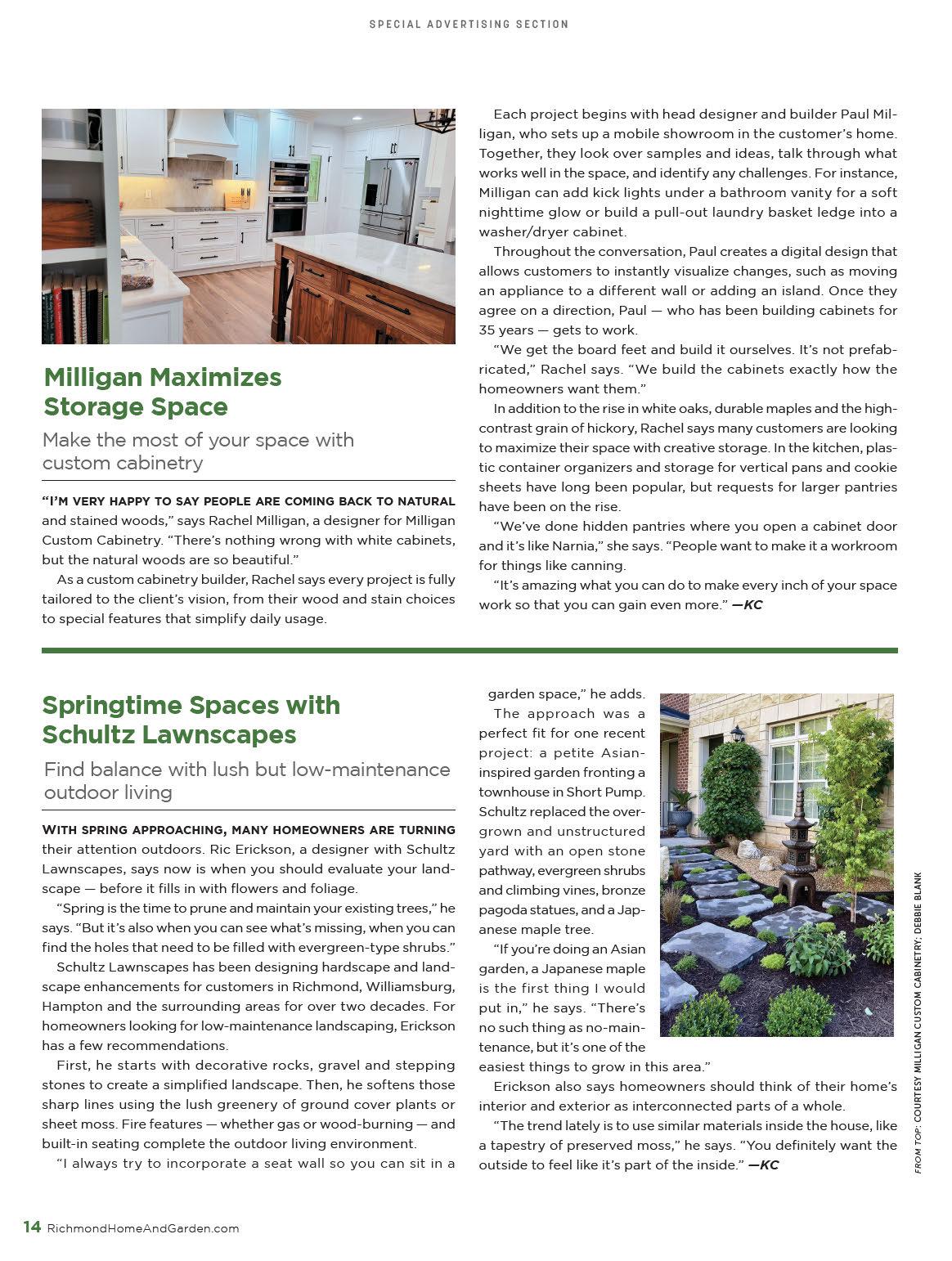
































































































































By Laura Anders Lee
Summer is still months away, and schools are trying everything to keep our students engaged.
My social media feed was recently filled with elementary school kids dressed as 100-year-olds to celebrate the 100th day of the school year. Some of them really got into it, donning wigs or powdered-gray hair, wearing spectacles, and using canes and walkers. While the kids were absolutely precious and hilarious, my practical side couldn’t help but think of the extra work it took parents to shop for costumes, get their children dressed and take Instagram-worthy photos before 7 a.m.
While theme days are meant to be fun, they notoriously catch me o guard. A mom in our sixth grade group chat recently texted, “Is it really pajama day, or is someone pulling a prank?” Posters were put up around school promoting Spirit Week, but nothing went home to notify the parents, leading to a communication mix-up. inking back over the years, we’ve participated in a parade of theme days. When my younger son, William, was in kindergarten, his teacher hosted a “Q” and “U” wedding to show that the le ers belong together. While the concept was cute, we scrambled to find formalwear for the ceremony. When my older son,
Anders, was in fi h grade, he gave me 18 hours’ notice to outfit him in head-to-toe yellow for a pep rally.
Various summer camps have called for even more items we didn’t already have so that the boys could participate in Camouflage Day, Hawaiian Shirt Day, Wacky Sock Wednesday and Tie-Dye Friday. Now a plethora of costumes and props are si ing in a bin, likely never to be worn again.
Despite the time, money and e ort required, Margaret Raigins, a Richmond mother of two who has taught preschool and first grade, reminds me that in today’s school environment, theme days are a relatively easy way to benefit students.

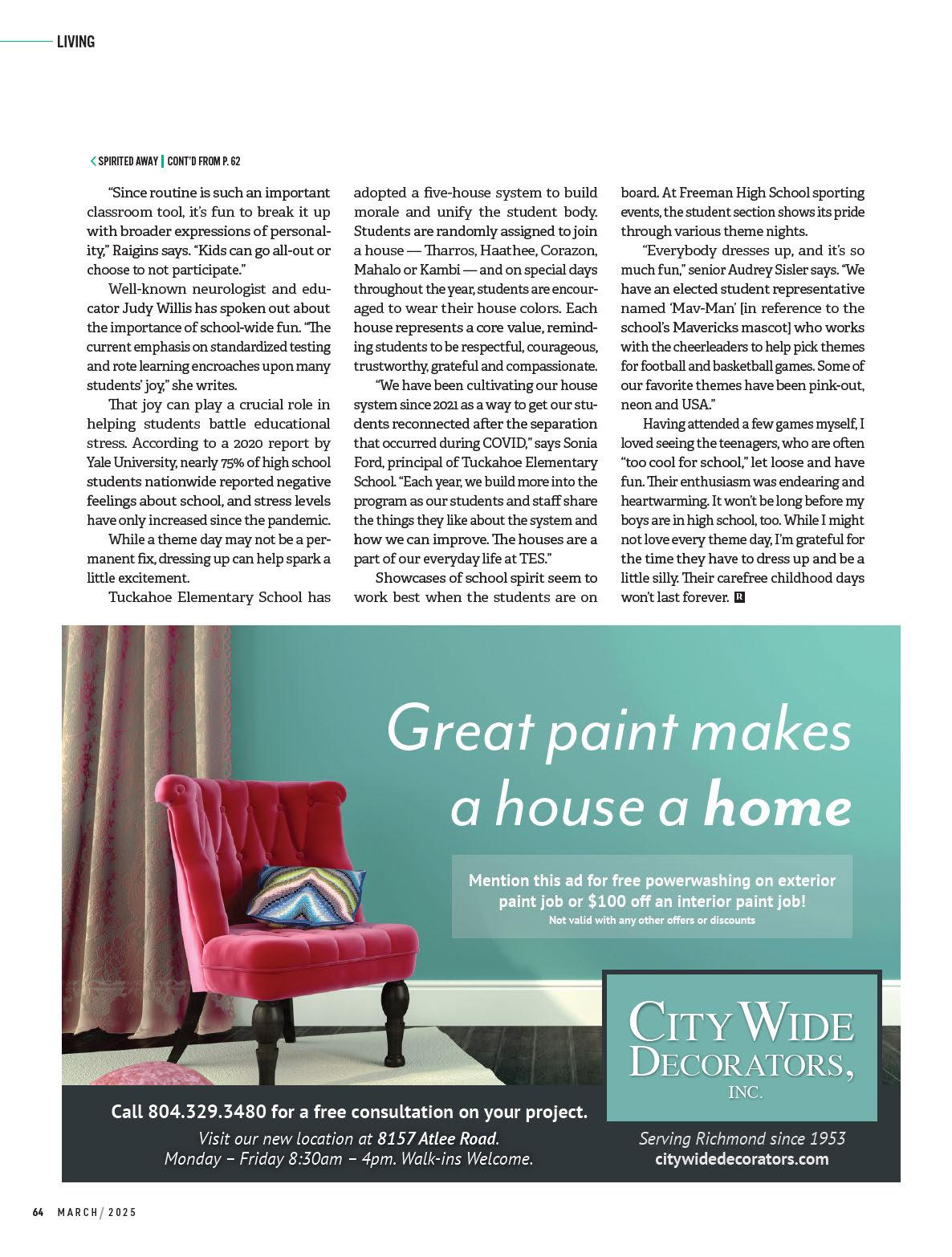


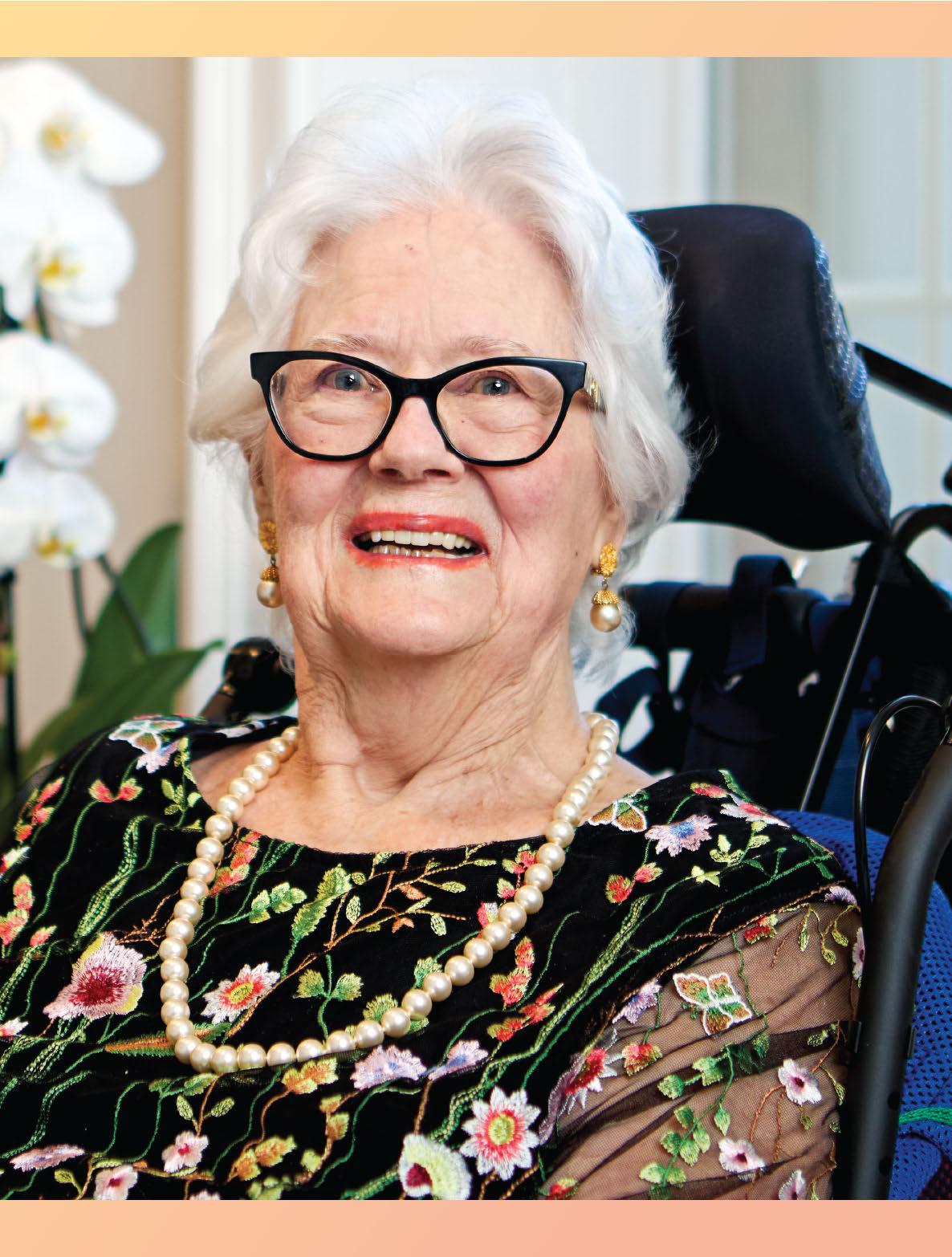
The staff at Westminster Canterbury Richmond, the retirement community where Patsy lives, can a est to that. A er a stroke limited her mobility in April 2024, Patsy hasn’t been able to a end the constant rounds of parties and events she did even a year ago. Nonetheless, the staff frequently li s her into the community van and takes her to the event du jour. “They put me in the back of the van and haul me off. I do that a lot. Honey, I have good parties that I want to go to,” she says with a grin.
Patsy is accompanied to events by family members or her cadre of companions — a group of talented and knowledgeable friends always willing to accompany her whenever and wherever she wants to go.
“Patsy has a very busy calendar, and she fills it with life, lots of variety, lots of fun,” says Zarina Fazaldin, the president of L&Z Historic LLC and a close friend of Patsy’s. “She enjoys her life in a full and spirited way.”
“She loves whatever is going on,” says Catherine Venable, an artist and another friend. “She loves the night life, she loves it so much, and she loves a banquet table. When you are with Patsy, you are doing four or five parties a night.”
Susan Morgan, a fellow member of Patsy’s posse and the editor of R•Home, a Richmond magazine sister publication, agrees. “Her joie de vivre is infectious,” she says. “Patsy’s changed my perspective. She still wants to be there, and to learn, and see, and do. She is a role model for aging gracefully.”
‘ALWAYS ABOUT THE ART’
A Richmonder since 1941, Patsy has been a constant of the city’s arts scene for decades — many of the parties she a ends are cultural events and fundraising galas — and she and her family have contributed to many iconic Richmond institutions over the years. Her husband, Hunter R. Pettus Jr., who
made his fortune with the Davenport & Co. financial services firm, died in 2013.
Of all the places the family has supported, Patsy’s first love is the Virginia Museum of Fine Arts, where she volunteered as a docent decades ago. “I think I was in my fi ies,” says Patsy, whose memory is starting to fade with age. “It was tiny, tiny, tiny back then. And they kept adding on wings. I have loved it always.”
“Patsy doesn’t have a degree in art history, but she would go to every talk, every lecture, on painting, textiles or architecture. She just absorbed it all,” says her son Edward, known as Ted, a professor at the Emory University School of Medicine in Atlanta.
it everywhere. Beauty is always there, and I found it all the time. I always kept my eyes open.”
Opposite page, clockwise from top left: Patsy Pettus celebrating her 95th birthday at Reveler with Diana Arenander; at the VMFA Samurai Armor exhibition opening party; with her namesake staircase at the Valentine.
Keeping her eyes open made Patsy a fixture at gallery openings, exhibits, lectures and, in fact, most of Richmond’s cultural events for the past seven decades. “She has been connected to so many groups and given money to all these groups and galleries,” Ted says. “The artists, the deans, the curators, the gallery owners — all the people who run [the Richmond art scene] now — she knew them when they were young artists living in a garage somewhere.”
“If there is an [exhibition] opening at the VMFA and they have four layers of parties, she goes to all of them,” Morgan confirms. “Then she goes to all of the lectures.”
Si ing in a wheelchair in front of a painting by the locally renowned artist and photographer Willie Anne Wright, whom she has known since the 101-year-old Wright was just getting started, Patsy puts it simply: “It’s always about the art.”
Wright is one of many Richmond artists whose work found a place on the walls of Patsy’s beautifully appointed room at the retirement community. Wright calls Patsy “a great lady of support for the artists of Richmond” and “one of the most active art lovers that we have ever had.”
Venable’s work is there too; the artist herself o en accompanies Patsy to gallery openings and other events. “Patsy loves art, probably more than any person I’ve known,” says Venable. “When she would travel, it was predominately about art. My love and respect for her is huge.”
Patsy describes herself as a frustrated artist. “I always, always wanted to be an artist. I just loved art, and I saw
“I just spread out,” Patsy says. “And I just spread and spread. I was everywhere. Really that’s how it went. I just couldn’t quit going. I’m just one of those people who loves art and loves life.”
Alex Nyerges, the VMFA’s director and CEO, notes, “What is striking about Patsy is her voracious curiosity. Unintimidated by new things or new ideas, she wants to soak up and understand everything. This drives her love of architecture and art.”
In unknowing agreement with her friends, Nyerges adds, “Patsy loves to be where the action is, whether it is in the company of artists and creatives or enjoying events at the Virginia Museum of Fine Arts.”
That curiosity leads Patsy to seek the history and cultural importance of anything that fascinates her. “There’s this constant hunger for learning that’s so admirable,” says her granddaughter Julia Pettus. “There is this childlike wonder.”
More than a decade ago Patsy enrolled in an art program at Virginia Commonwealth University. She was smi en, and the courses in architecture inspired some of her most memorable
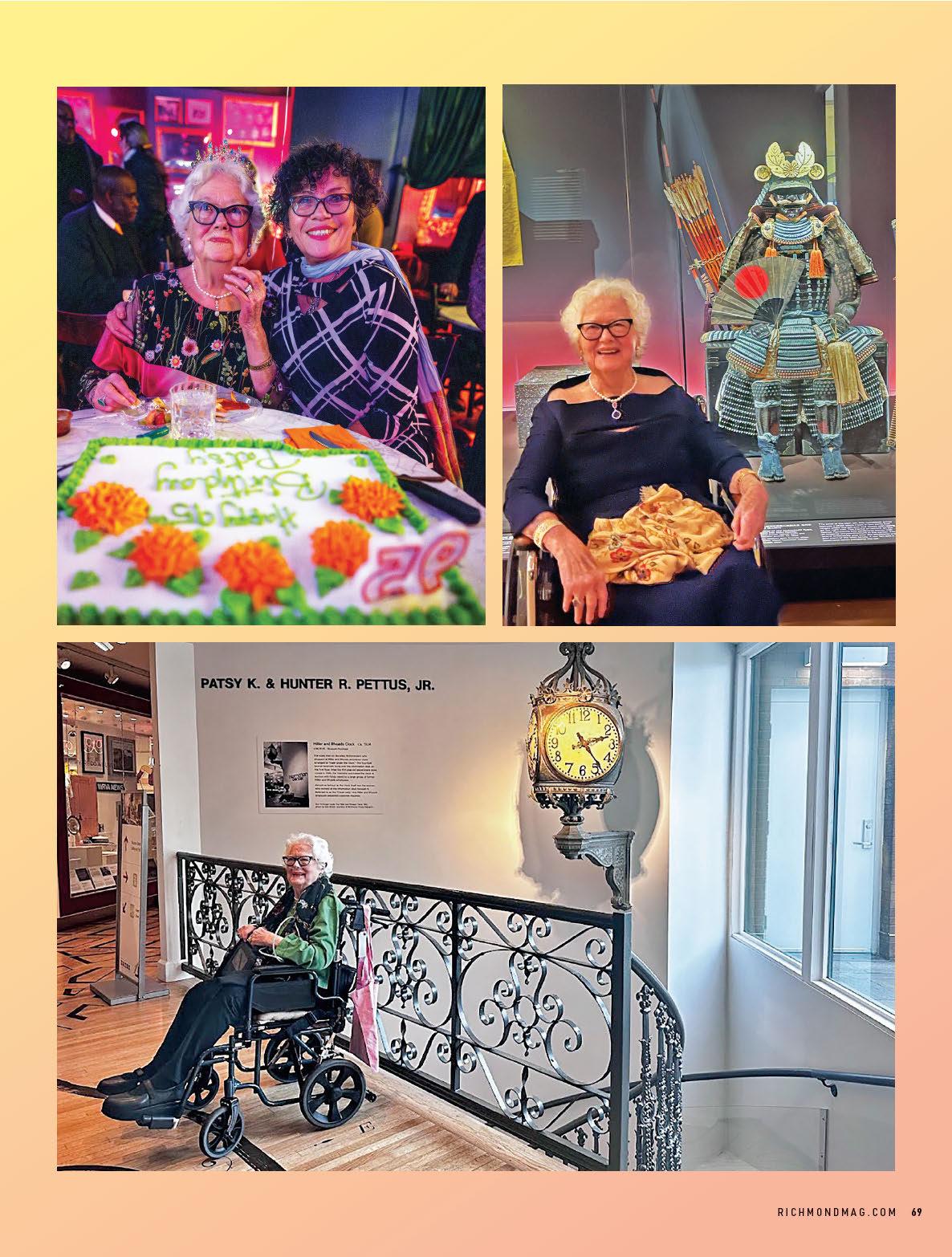
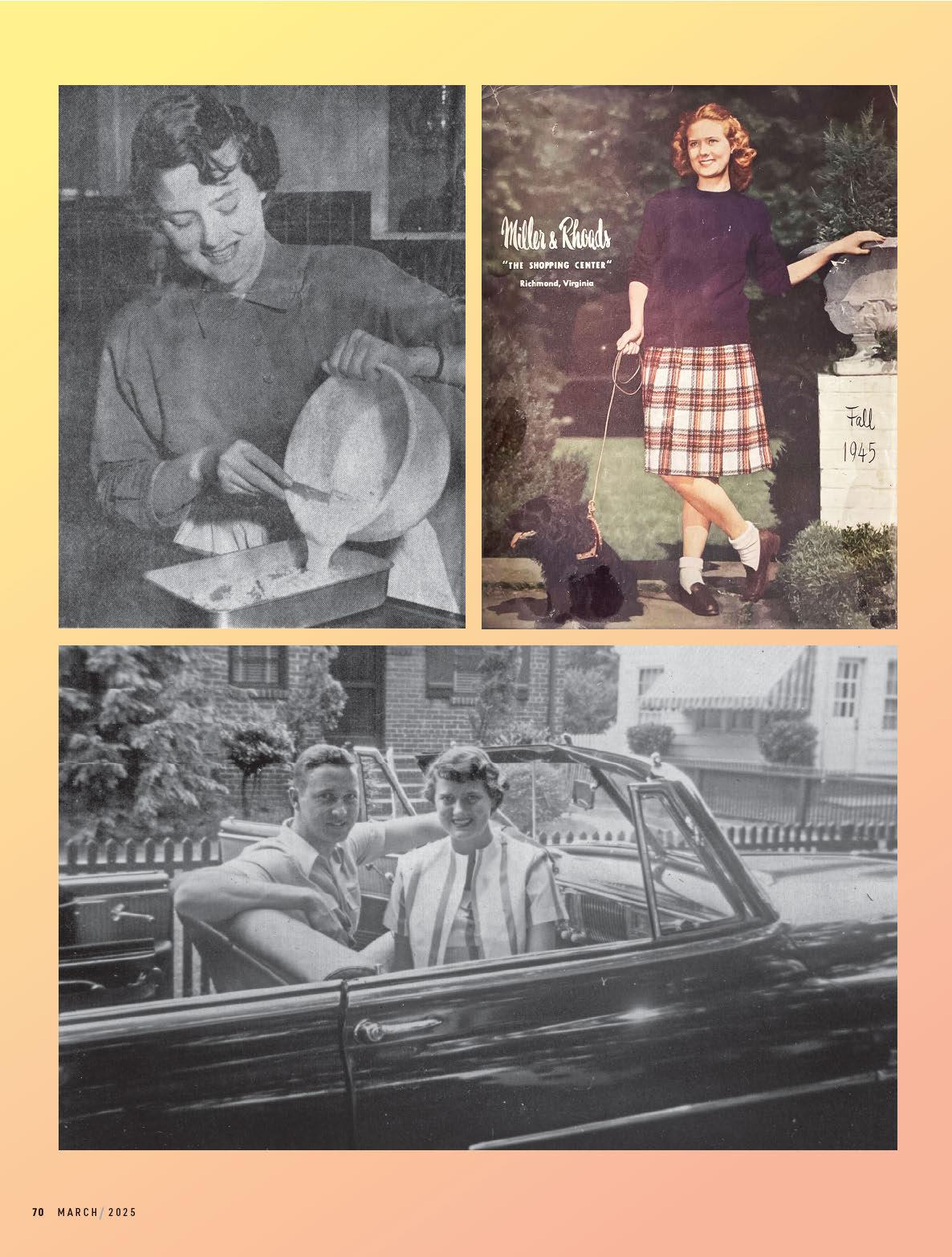
trips around the world. She joined the Center for Palladian Studies, named for a Renaissance master architect who influenced British and American architecture; the Antiquarian Society of Richmond; Historic Richmond; the Decorative Arts Trust; and Ikebana of Richmond, to name but a few.
Her passion for architecture spurred Patsy to donate millions to projects around the city and led her to be dubbed “The Staircase Lady,” a moniker that draws an amused smile from her.
It started with a donation Patsy made to the Valentine museum in memory of her husband. William “Bill” Martin, the museum’s director, named the staircase with the iconic Miller & Rhoads clock over it for Patsy and Hunter, which was apt because the famous Richmond department store played a role in Patsy’s younger days.
She then contributed to Virginia Commonwealth University’s Institute for Contemporary Arts, a project that in 2018 Architectural Digest named one of the most anticipated buildings worldwide. “We gave them a million dollars to help them get opened,” Patsy says, referring to her family, although the magnificent stairway that defines the building’s entry was named for Hunter and her. She adds o andedly, “A er that, we kept giving more money for different things.”
“Patsy Pettus and her family’s unwavering commitment to architecture and design has helped to transform VCUarts,” says VCUarts Dean Carmenita D. Higginbotham, Ph.D., of the family’s support. “This dedication … ensures that the performing arts, design and the visual arts are permanent and prominent fixtures in our community … [and propelled] VCUarts forward as an internationally renowned school of art and design.”
After the ICA, Patsy made dona-
tions to Monumental Church, one of America’s earliest and most distinctive Greek Revival churches, and the Virginia Museum of History & Culture, among other organizations. In all, thanks to her, six staircases around the region were built or renovated. Patsy has also pledged donations to the VMFA’s upcoming expansion and renovation project as well as VCU’s CoStar Center for Arts and Innovation, under construction across the street from the ICA. Surely more Patsy and Hunter Pettus staircases are coming soon.
Last year, Patsy celebrated her 95th birthday by touring her staircases on a trolley filled with family and friends. In the video of the tour, she sits front and center, with her posture reflecting the model she once was and her expression as regal as a queen’s.
Patsy’s love of style and ceremony started at a young age. Born in 1929 in Arkansas, she moved to Virginia in 1941 when her father went to work at Naval Support Facility Dahlgren. Her family se led into the Forest Hill neighborhood of Richmond, and Patsy a ended the old John Marshall High School, which she still remembers with some sadness as “the beautiful building that’s gone now. That was a handsome building.”
While she was in high school, Patsy palled around with June Carter, the country music icon who later married Johnny Cash. “June and I dated the same guy,” Patsy recalls. “I had to be home early, so he would take me home and then take out June. I didn’t mind. June and I were the best of friends.”
Patsy and June also dated another high school classmate: Hunter R. Pettus Jr. “You know that question in high school yearbooks, ‘Where do you expect to be in 10 years?’” Patsy asks.
“I said, ‘At the front door, waiting for my great husband to come home.’”
But it wasn’t a straight line from high school to husband.
“I was like 15 years old when I was chosen to come and do a Miller & Rhoads catalog cover,” Patsy says. “They just thought I was good-looking or something, I guess, because they just chose me above a lot of other people.”
During its heyday in the mid-20th century, Miller & Rhoads was considered one of the best department stores in the South, famed for its seasonal Santaland and the Tea Room where ladies lunched on Brunswick stew and chocolate silk pie while enjoying a fashion show. Being selected for the cover of the store’s catalog was a distinct achievement for a young Richmond woman, and it launched Patsy’s modeling career.
“A er that, I was all over the place. I was invited to go to Thornton Modeling Agency,” she says, referring to The Walter Thornton Modeling Agency, considered to be one of three top modeling agencies in the country. Patsy worked in Washington, D.C., and then got her big break in New York City. But it wasn’t for her.
“I decided I didn’t want to do it when I got there and saw how people acted. It was kind of wild,” Patsy remembers. “I wasn’t ready for any of that, so I went home.”
She studied at Longwood College (now Longwood University) in Farmville and earned a degree in home economics. A er graduating in 1950, Patsy moved back to Richmond and took a job with General Electric showing housewives how to use the latest high-tech equipment: electric stoves.
“I loved to cook,” she says, which is evident in aging newspaper articles, where she can be seen hovering over a large pot as four or five other women look on. She combined her modeling experience with her home economics skills to become a “home economics force,” Ted says. Even decades later,
Patsy appeared in several stories on the food and society pages of Richmond newspapers with recipes she created and receptions she a ended.
Patsy’s career in home economics ended when she married her old high school flame, Hunter. “I got married and had a wonderful husband and had four fantastic sons, and that kept me busy, honey,” she says with a laugh.
Patsy might have been busy, but she wanted more.
“She was always hard charging on exploring the world, doing her thing,” says Patsy’s third son, Rob, who, with his wife, Jayne, still lives in Richmond. “She came to the family one night when I was about 13 years old and announced her retirement from motherhood.”
Rob says he and his three brothers — Reggie, who lives outside of Charleston, South Carolina; Rich, who is in Asheville, North Carolina; and Ted — “kind of looked at each other, and were like, ‘Wow, okay, what does she mean?’ She’s like, ‘I’m going to be charging out of here the moment your father gets home from work to go explore my world.’ She would leave a dinner in the oven and go flying out of the house.”
Patsy describes her late husband as quiet, introverted and serious. “He was a good homemaker. He liked to stay home with the children,” she says. “And I le him with the children a lot, because I had to see the world. And he allowed that. Seeing the world was the primary thing in my life, and I am so happy that I have. I have so many wonderful memories.” Patsy has visited every continent except Antarctica.
“The travel bug came all from her,” Rob confirms. “All of her sons love exploring the world and seeing new things. That definitely came from my mom’s side. My dad was happier si ing at home reading the Wall Street Journal.”
During her travels, Patsy didn’t
stay at exclusive resorts or five-star hotels. “Another thing I did that was different was I joined the Friendship Force and saw part of the world with them,” she says.
A nonprofit started in 1977 and supported by the late President Jimmy Carter, Friendship Force International aims to improve intercultural relations and encourage friendship by sending ordinary people to partner cities to immerse in the culture. “Families would come here and stay with us and vice versa,” Ted says.
As she grew older, Patsy swapped immersive travel for trips with her grandchildren. She would give them a free trip and they would help her get around. “Later in her life, she would take the entire family on cruises all over the world,” Rob says. “It was great bonding time.”
for an event. Others in the group, most a generation younger, went back to the hotel to go to bed. Not Patsy.
“Patsy really likes jazz, so we went to a jazz club and some guy at the door wouldn’t let us in. They were packed. At the time, Patsy was using a walker. So, she played the old lady card. She looked at the guy and said, ‘Don’t you have a spot an old lady can park her walker?’
Opposite page, clockwise from top left: Patsy with Janne Sirén, director of the Bu alo AKG Art Museum; the Pettus family; with Zarina Fazaldin at the 2023 Richmond Folk Festival; at her 90th birthday party with Catherine Venable.
“I took Teddy a lot,” Patsy says, referring to her son Ted. “My baby boy was 15 years younger than the oldest one, and he became my pet.”
With that, Ted beams.
The pair logged their first trip together to Costa Rica when Ted was 10, and they’ve journeyed to places far and near ever since. “We love going to New York City together. We go together a lot,” Patsy says.
“It is always kind of magical traveling with her. You end up meeting people out of nowhere. You don’t even have to try. They come to her,” Ted says.
Describing herself as curious, Patsy says, “I just find interesting things to do and see. I could just keep going. I didn’t need to stop and rest. I had a lot of energy. It’s hard to describe to you the amount of energy I had.”
Patsy Pe us’ energy is legendary. Ted tells of the time a decade ago when they were in New York City together
We were in. The young people were just blown away by this co on-top lady totally into jazz.”
Then there was the time Patsy, in her 80s and with a walker, really wanted to go to one of the oldest blues clubs in the nation. Undeterred by the long staircase to the door, she took her walker up one step at a time until she reached the club, where she was ushered in like royalty for her efforts.
“She always told us that at her funeral, she wanted a big party,” says Patsy’s daughter-in-law Jayne, whom Patsy credits with throwing a great party. “We always joke that Patsy has FOMO, fear of missing out. I said, ‘Instead of having a funeral, why don’t we throw you a big 90th birthday party?’ She thought it was a fantastic idea.” Jayne planned a party for the ages. Held at the ICA shortly a er it opened, the event featured costumes, acrobats, musicians and even a server dressed in a huge hoop skirt that doubled as the dessert table.
As Patsy reflects on her life … Well, actually, she doesn’t. She revels in her happy memories but treats every day as a new adventure.
As her granddaughter Julia says, “Patsy has taught us all how to squeeze every drop out of life. We have learned to go out to the world and shake its hand.”
Si ing in her wheelchair, her eyes bright even if her mobility is limited, Patsy says, “I haven’t given up going.” R

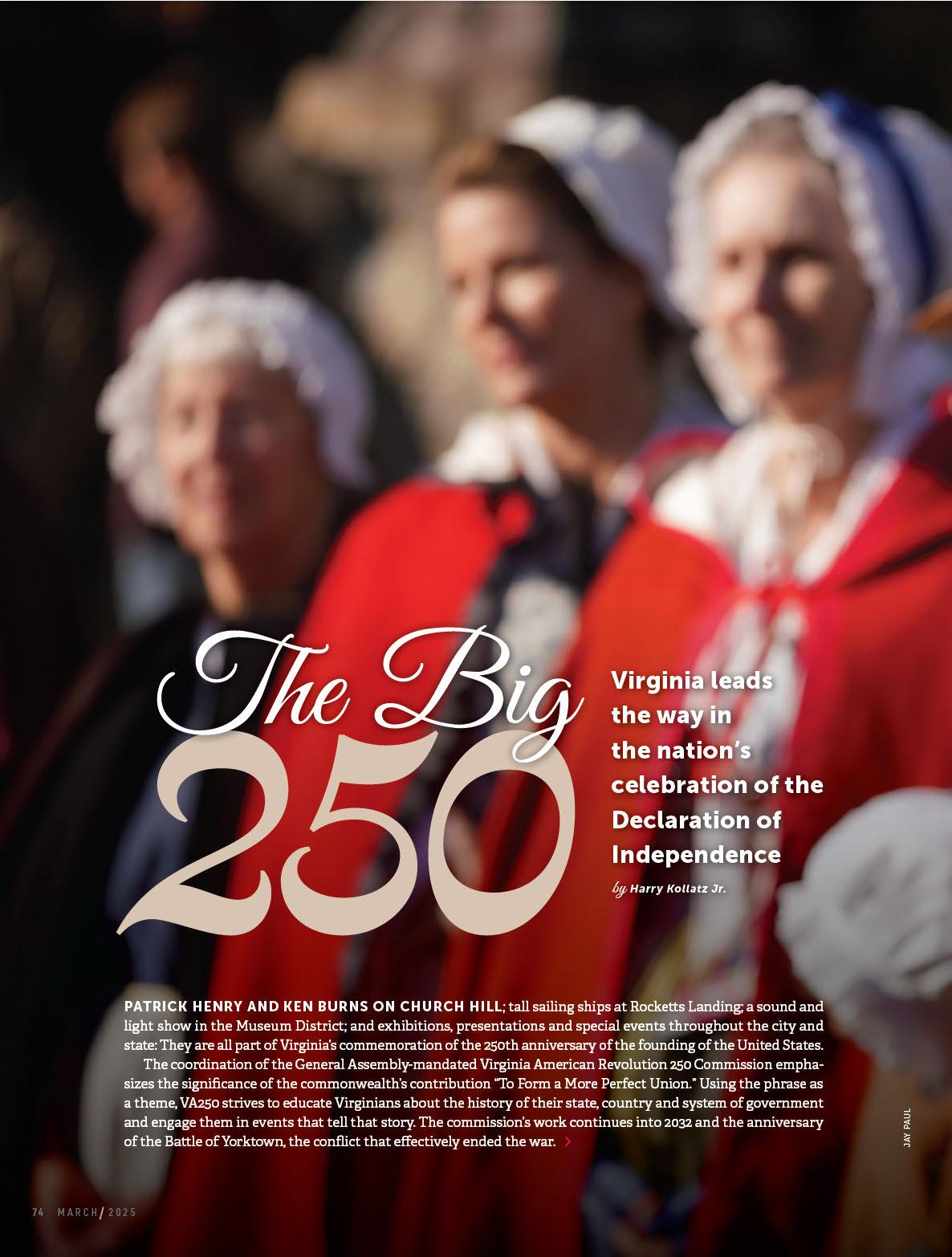

“It’s quite powerful to walk in these places, o en on the day the event happened,” reflects Cheryl Wilson, the commission’s executive director. “The years separate you, but you’re standing in the exact spot.”
Wilson has served as a legislative assistant in the General Assembly for 35 years and as such worked on the statewide commemorations for the Civil War at 150, World War I at 100 and World War II at 75, among others. Those events led to the creation of the current model, involving statewide partners. They also inform the present project; for example, specific concentration by VA250 on the Black and female experiences are in part based on the remembrances of the 1619 arrival of enslaved Africans in Virginia and the 1920 ratification of women’s suffrage.
However, the current commemoration marks not just the 250th anniversary of the United States but the significant and enduring role of Virginia during the Revolutionary War and the country’s early years. As the commission’s website notes, “Virginia’s History is America’s Story.”
VA250 amplifies community commemorations by offering grant funding available through state agencies, such as those for tourism, arts and the humanities. “On top of that, we help them promote their events [and] provide logistical support,” Wilson explains. “We’re there as a resource.”
Each state supports a similar commission, but Virginia’s is one of the most robust. “This is how you tell tough history well,” Wilson says.
Among VA250’s signature events are three sold-out reenactments of Patrick Henry’s “give me liberty” speech on March 23 at Historic St. John’s Church in Richmond; the Virginia International Ta oo in Norfolk April 24-27 featuring civilian and military performers from seven nations; Independence Day pageantry at Fort Monroe in Hampton on July 4 and at River’s Edge Park in Roanoke on July 5; and the recently ended commemoration of Marquis de Lafaye e’s 1824 visit to Virginia. Dozens more locally sponsored events will take place across the commonwealth.
An interactive mobile museum experience called “Out of Many, One” was launched in Roanoke in January. The expandable trailer will travel for three years with the goal of having students from every middle school in the state tour

the exhibit, which includes videos, photos and touchscreen displays highlighting the roles of ordinary Virginians as well as famous historical figures. Similarly, the trailer’s exterior displays an array of faces — some famous, some folks. VA250 wants to li up the awareness of this semiquincentennial moment and perhaps inspire visitors to both a end events in their localities and volunteer to assist in the productions.
The General Assembly chartered the commission in 2020. “Proud to say we were one of the first to start thinking about it,” says Jamie Bosket, the president of the Virginia Museum of History & Culture. During 2017-2018, the VMHC (formerly the Virginia Historical Society, which marks its bicentennial in 2031) contacted museum leadership statewide to start the process for remembrance. “That led into VMHC encouraging the General Assembly to create a formal commission, which they did, named us as part of the executive commi ee, and so the rest is history.”
Bosket already knew of significant dates and ways to
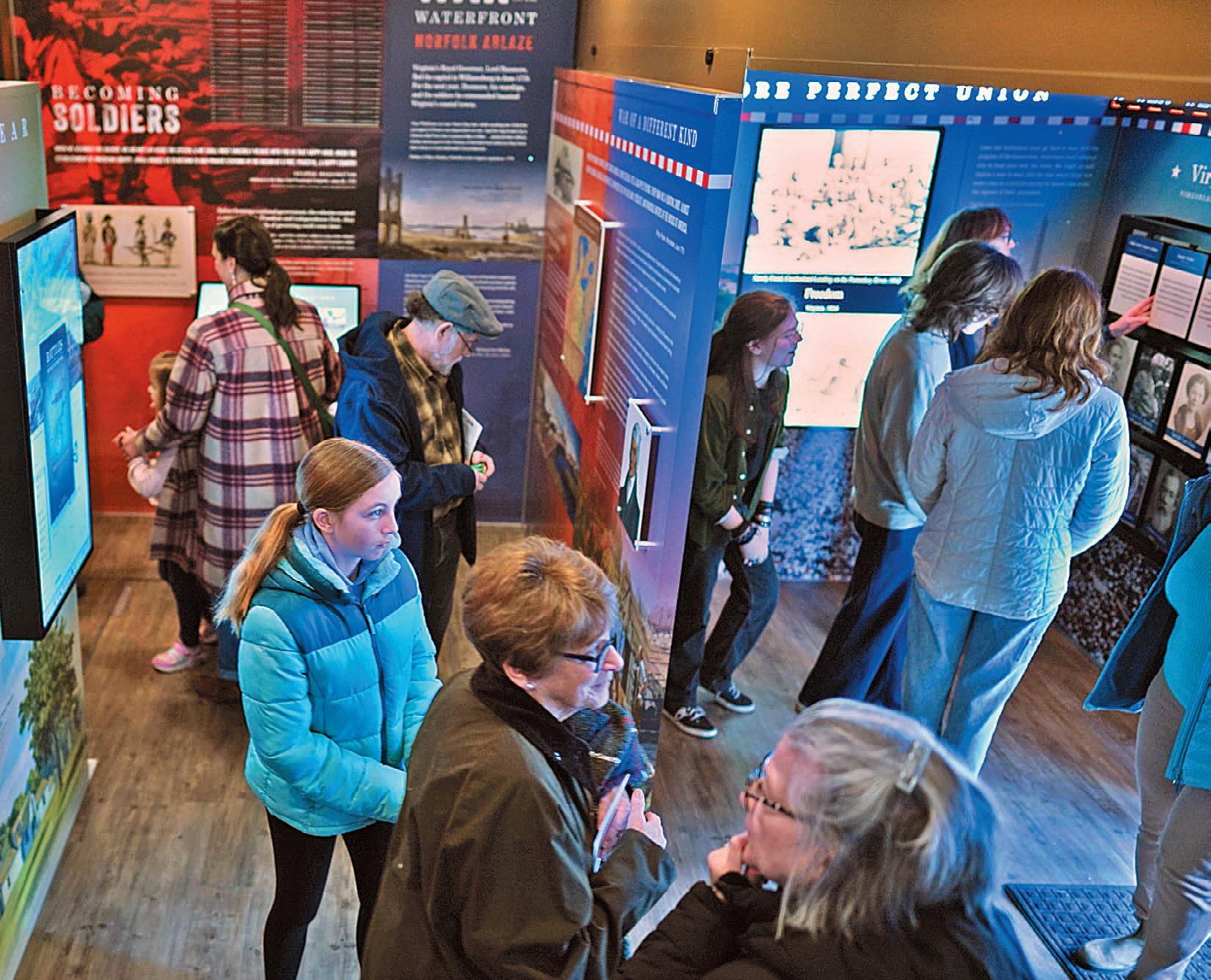
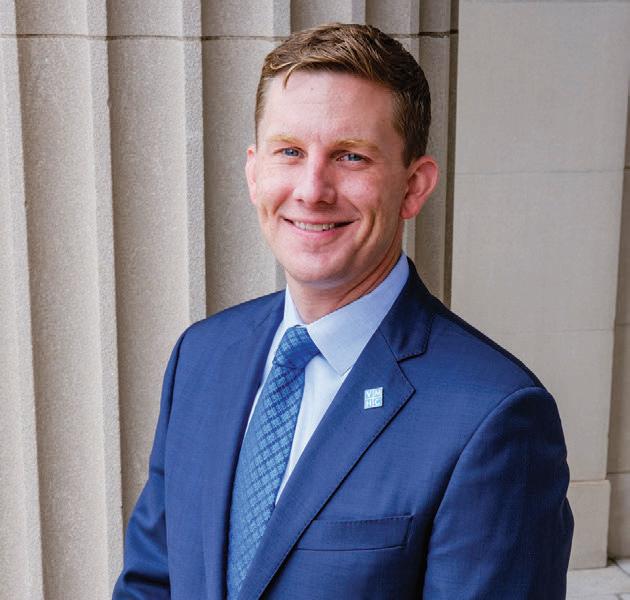
examine the complexities of history that would encompass everyone. “As individuals, we celebrate our birthday,” he says. “But it’s not just about the day we were born; we talk about the life we’ve lived. And I think commemorations are best done when everyone can see their connectivity to it, when you can actually talk about a journey, not just a point in time.”
The museum’s keystone contribution toward the commemoration is “Give Me Liberty: Virginia & the Forging of a Nation,” a five-section, 5,000-square-foot exhibition created in collaboration with the Jamestown-Yorktown Foundation. It opens at the VMHC on March 22 and runs through Jan. 4, 2026, a er which it will travel to the American Revolution Museum at Yorktown. A version of the showcase will be installed at Richmond International Airport in July 2026.
“Yes, we are borrowing those words from Patrick Henry’s speech,” Bosket says. “[They] are as interesting and compelling

now as they were then, especially when you consider them in different dimensions. What did ‘give me liberty’ mean then, and what does it mean now? What are our aspirations for what it should mean? The exhibit will take you a bit on that journey. … You will see all the iconic people that played a huge role and people you may not have heard of who were caught up in history. And, in addition, there’s some real showstopper artifacts in the mix.”
Among the items showcased are the whalebone paper cu er that Henry used to emphasize “death” in his speech and a pair of his eyeglasses which, one observer remarked, brought to mind a knight raising a helmet’s visor when Henry li ed them to the top of his head. A portrait of a young George Washington, proudly posed in his British regi-
mental uniform, will be displayed near the sword he carried in service of the Crown during the French and Indian War. His journey from loyal citizen of the British empire to leader of a breakaway republic is one part of a complicated story. But far from focusing on the Founding Fathers, the exhibition also portrays the roles of Indigenous and enslaved peoples, who fought on both sides of the war — Virginia’s last royal governor, John Murray, the fourth Earl of Dunmore, offered freedom to those who rallied to the British standard, while others hoped the Revolutionary cause would lead to liberty. The contributions of women are highlighted as well. For example, Clementina Rind took over her husband’s Williamsburg printing business a er his death and continued producing official documents and the Virginia


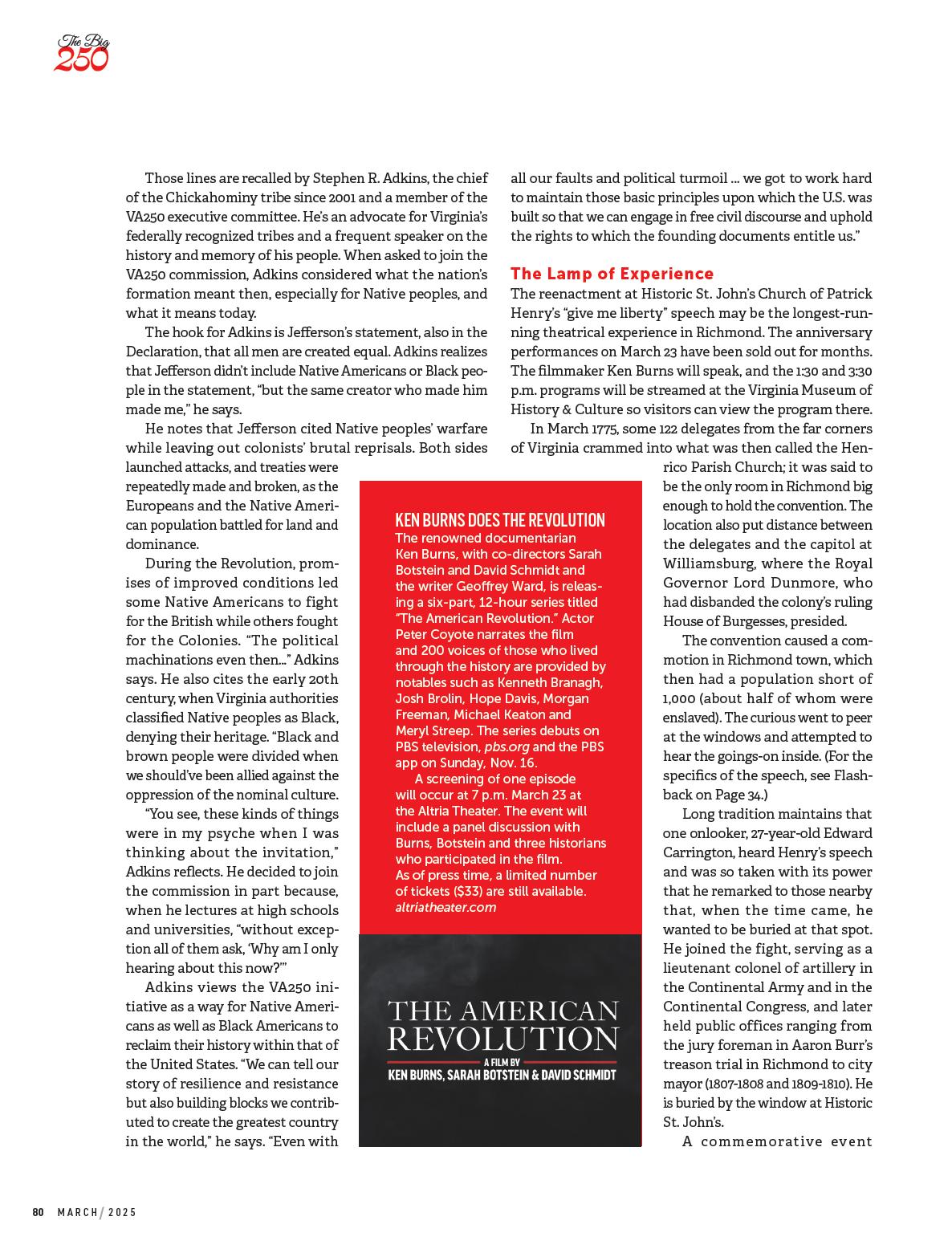
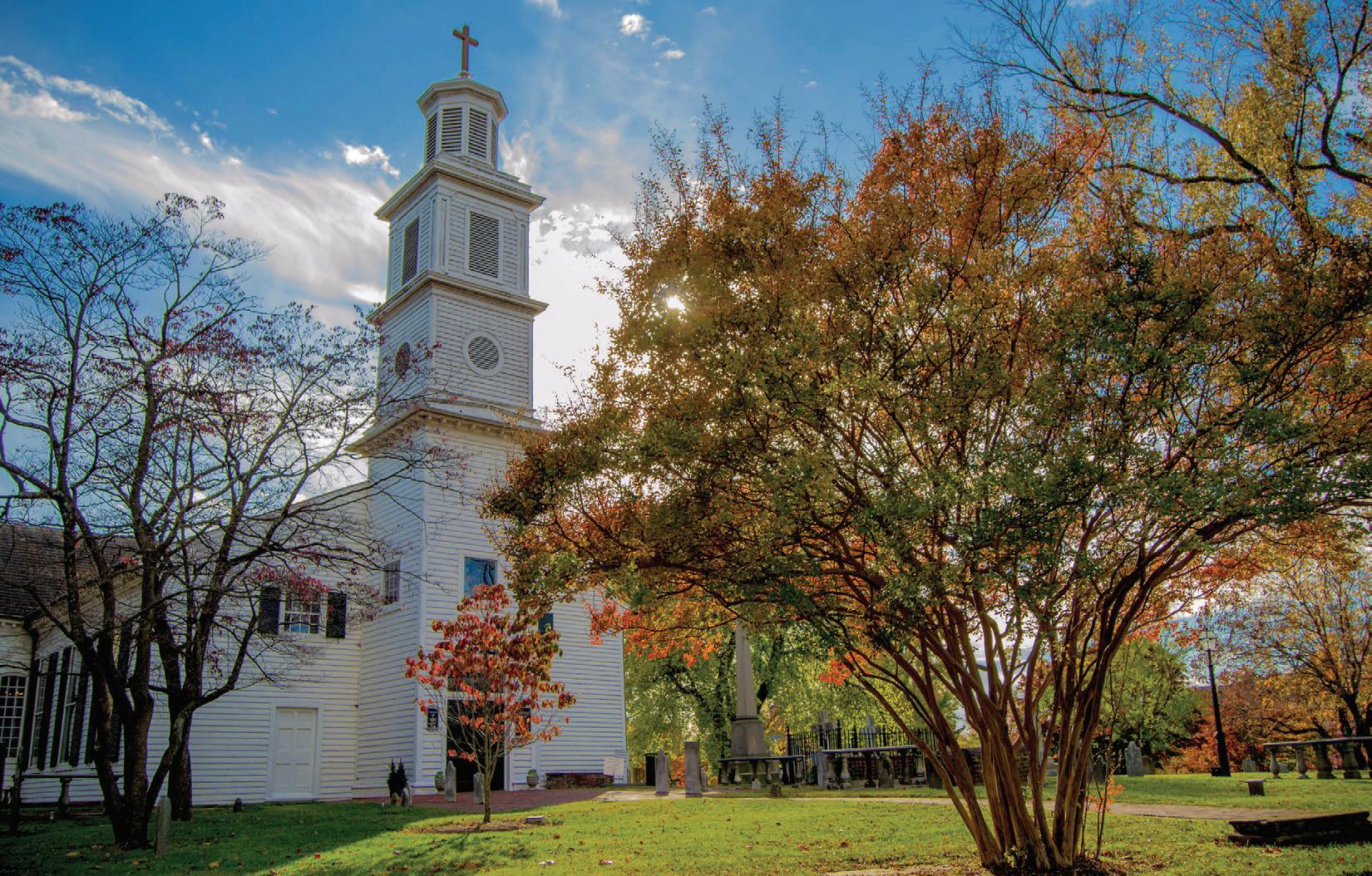
occurred in 1927 using a script created by then state archivist Hamilton James Eckenrode and Richmond News Leader newspaper editor Douglas Southall Freeman, who also portrayed Henry. His voice was broadcast over the airwaves of WRVA radio.
In 1975, actors from the Barksdale Theater — the production company based at the old Hanover Tavern, where Henry briefly tended bar — performed at the church on the anniversary date for invited guests. Burt Edwards headed the cast of 12 and a Barksdale founder, Muriel McAuley, directed. Either McAuley or another founder, Nancy Kilgore, recalled the event in “Going On…” a history of the theater’s first 31 years: “It was humbling, performing in the same spot, on the same wide floorboards, looking through the same windows, si ing in the same pews — everything the same except the moment.”
The program moved that a ernoon to the Richmond Coliseum for a show that was open to the public. Several old church pews were brought in as a minimalist set. The audience of 3,000 paid a dollar each for the costumed reenactment, patriotic and historic music performed by Langley Field’s Tactical Air Command Concert Band and the Fort Myer Old Guard Fife and Drum Corps, and 18th-century military drills by the Fort Myer George Washington Com-
mander-in-Chief ‘s Guard of the Revolution, dressed in bright Continental Regular uniforms.
A few weeks later, the cameras of WCVE, then the local PBS affiliate, recorded the reenactment at the church, which was broadcast throughout the country. The show was brought back in summer 1976 for the nation’s bicentennial and has continued ever since, presented on Sundays from Memorial Day to Labor Day weekends. In addition, 100 reenactments are presented off-site at schools and special events each year.
The script was fine tuned in the 1990s and the cast rotated, although some members stayed on for decades. The present production is managed by stage veteran Dean Knight, who portrays Richard Henry Lee. “It’s a great part,” he enthuses. “Lee as a speaker is second-only to Henry — and he seconds the resolution to form a militia.”
Stephen P. Wilson, the director of the St. John’s Church Foundation, expects some of the excitement of 1775 to be replicated this year as audiences come and go for the three anniversary shows, each of which has a different Henry. “Some people will hear about this on the news,” Wilson predicts, “and they’ll show up without tickets, and then maybe some of them will be like Edward Carrington at a window.”
For more semiquincentennial events in Richmond and across the commonwealth, visit va250.org. R
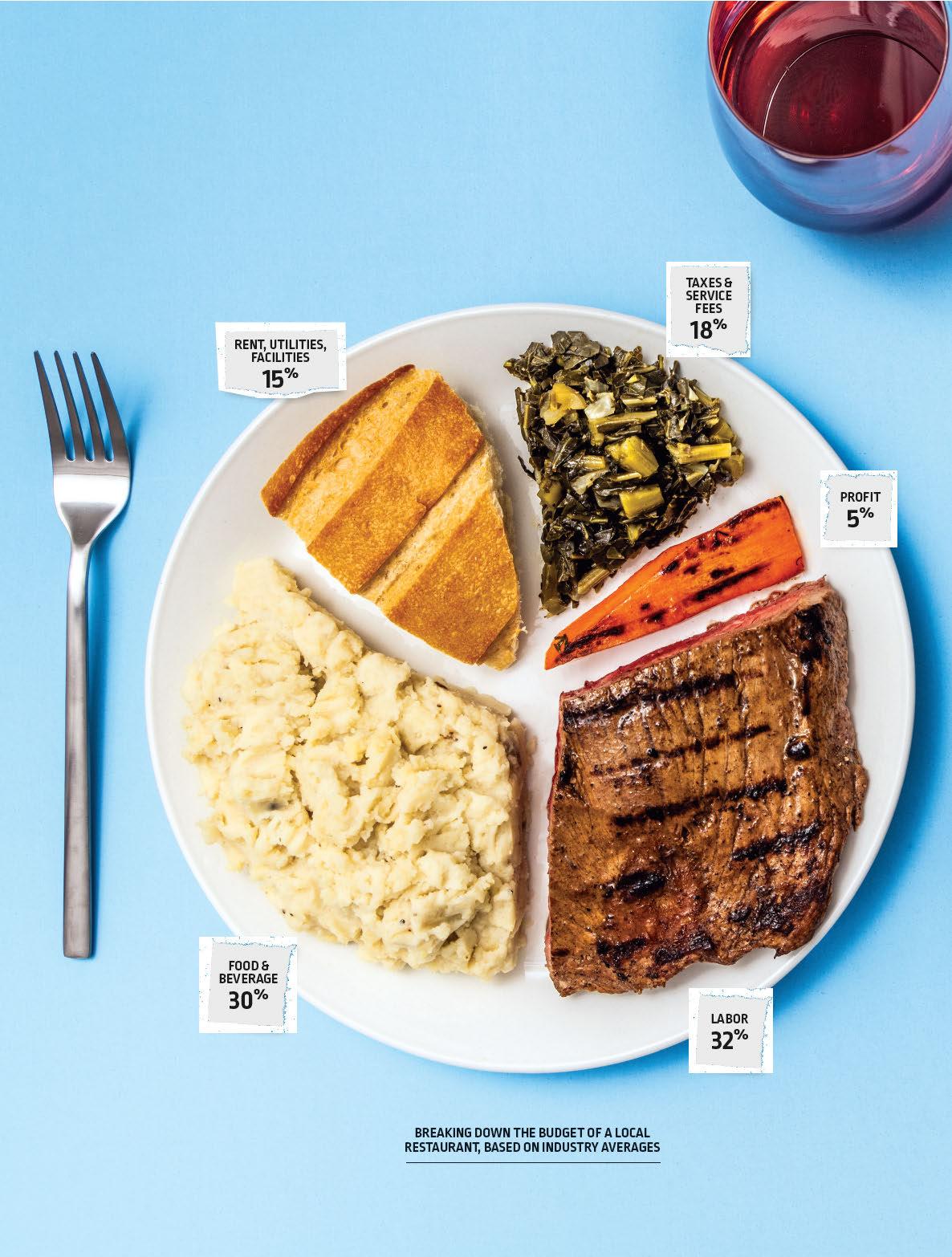

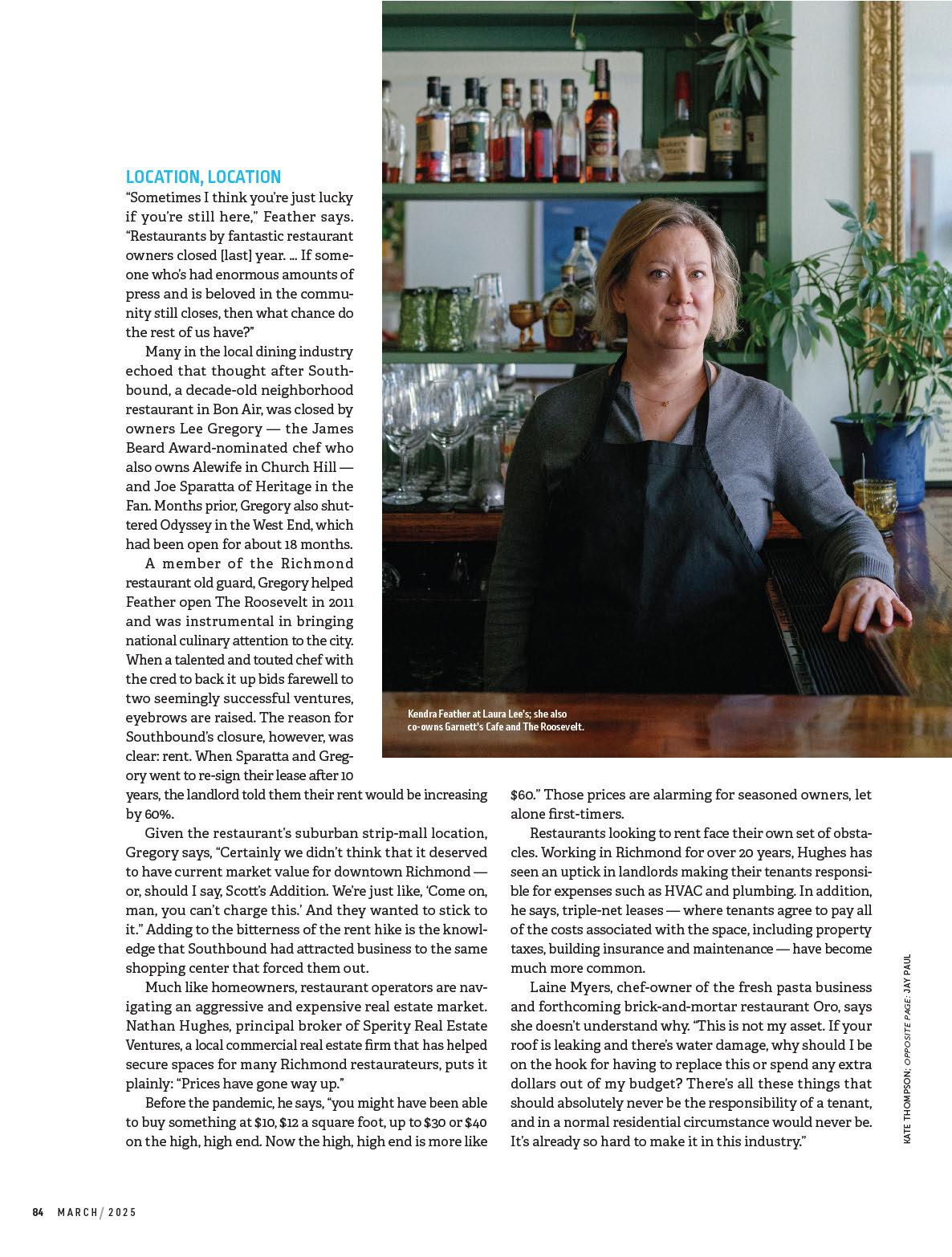

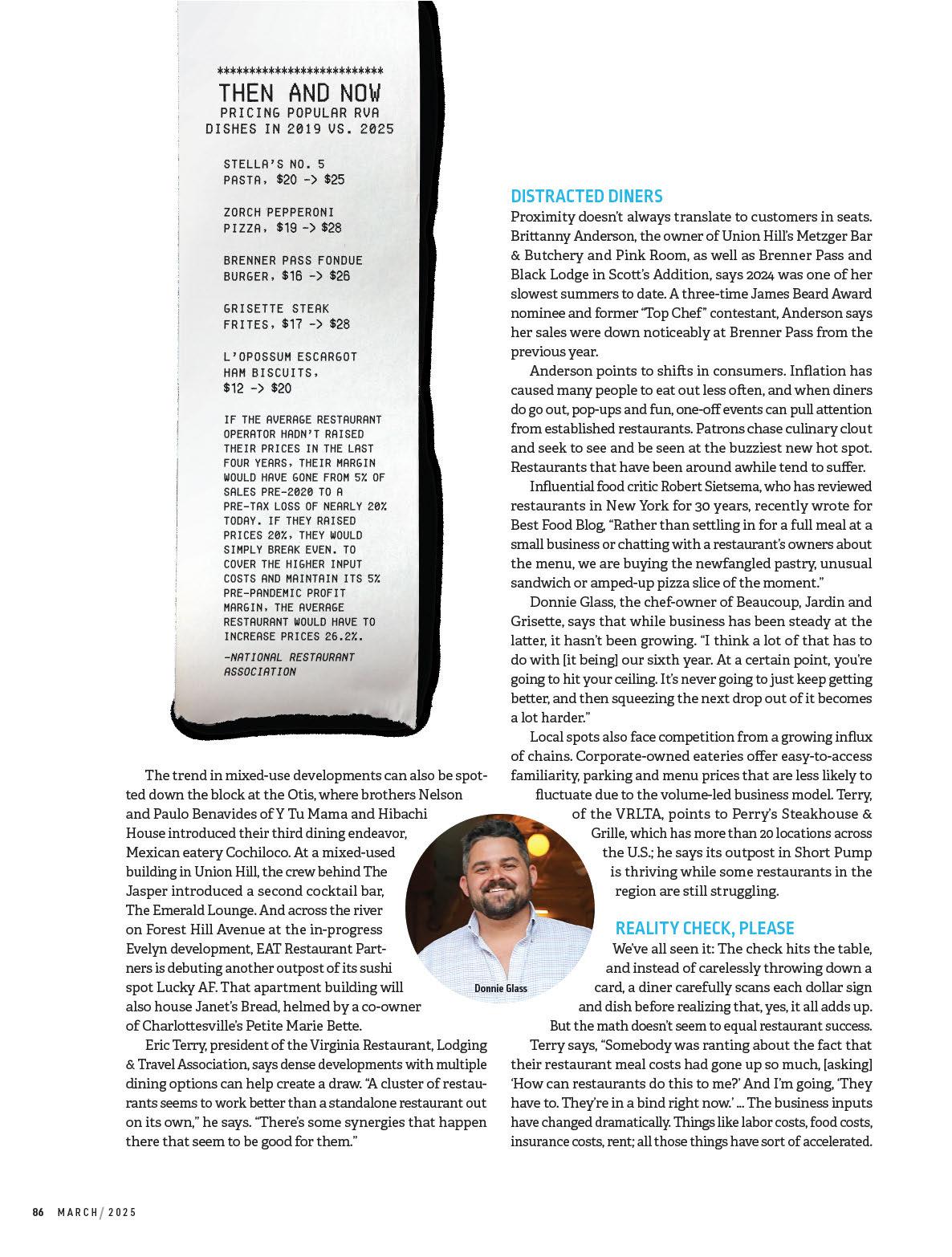


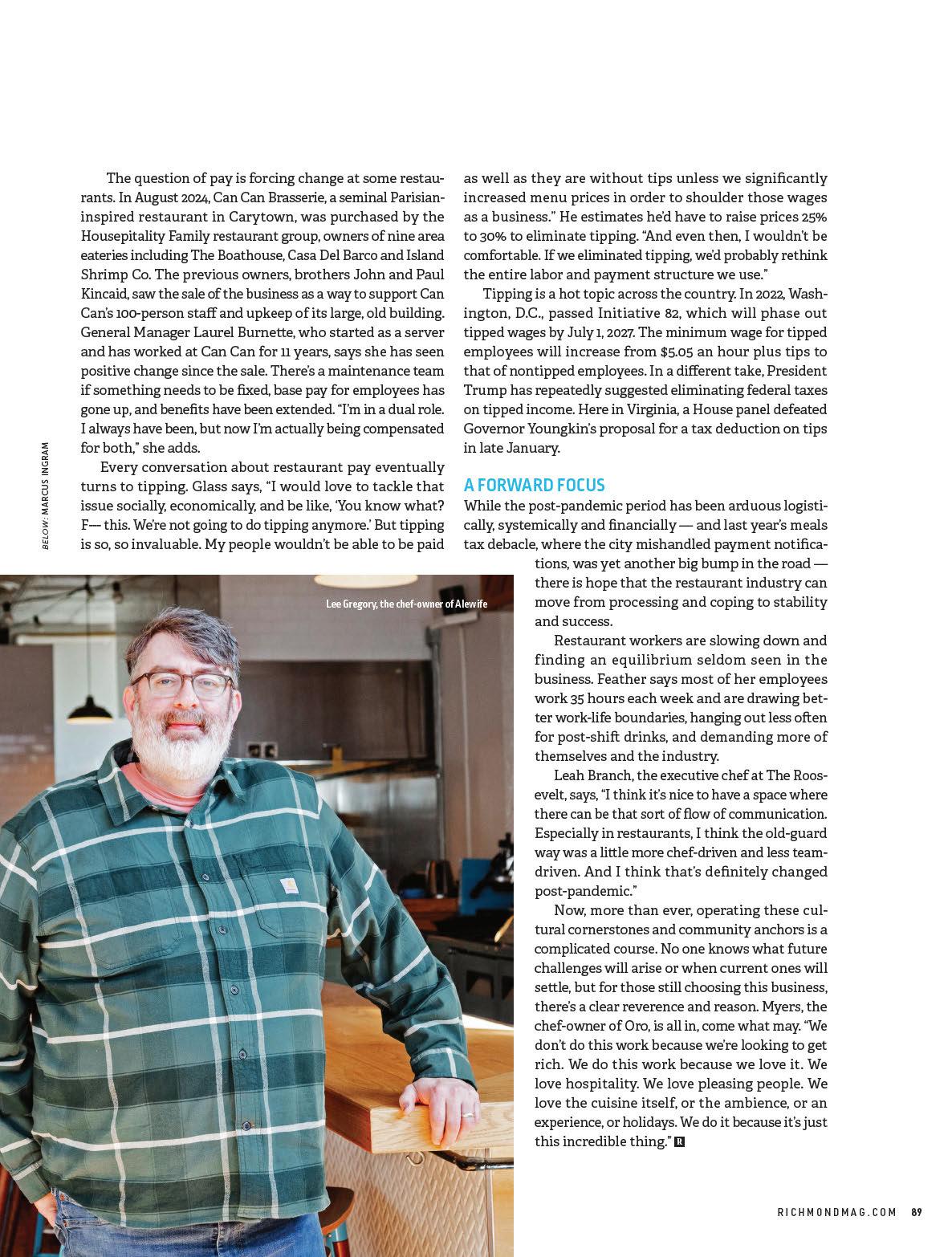
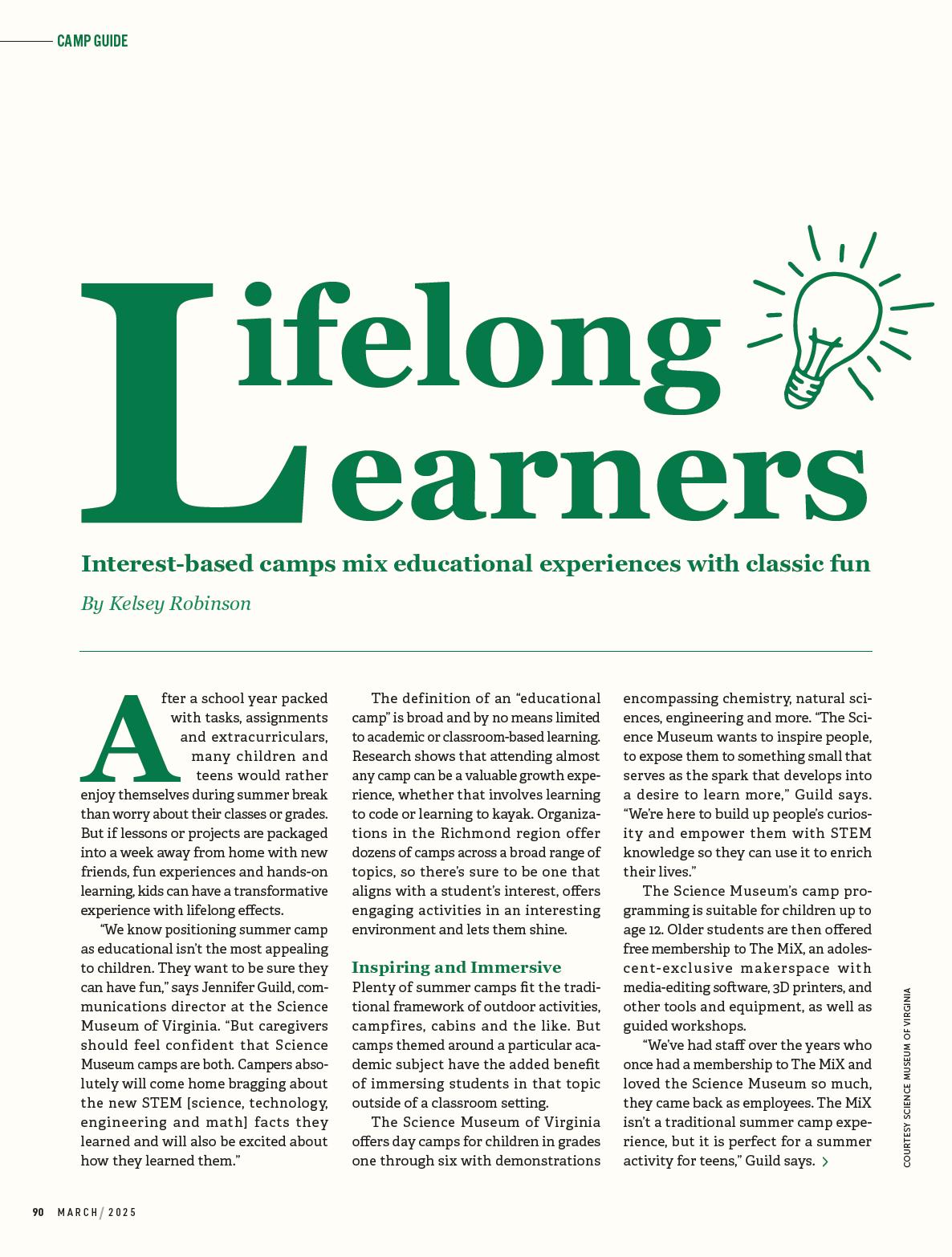
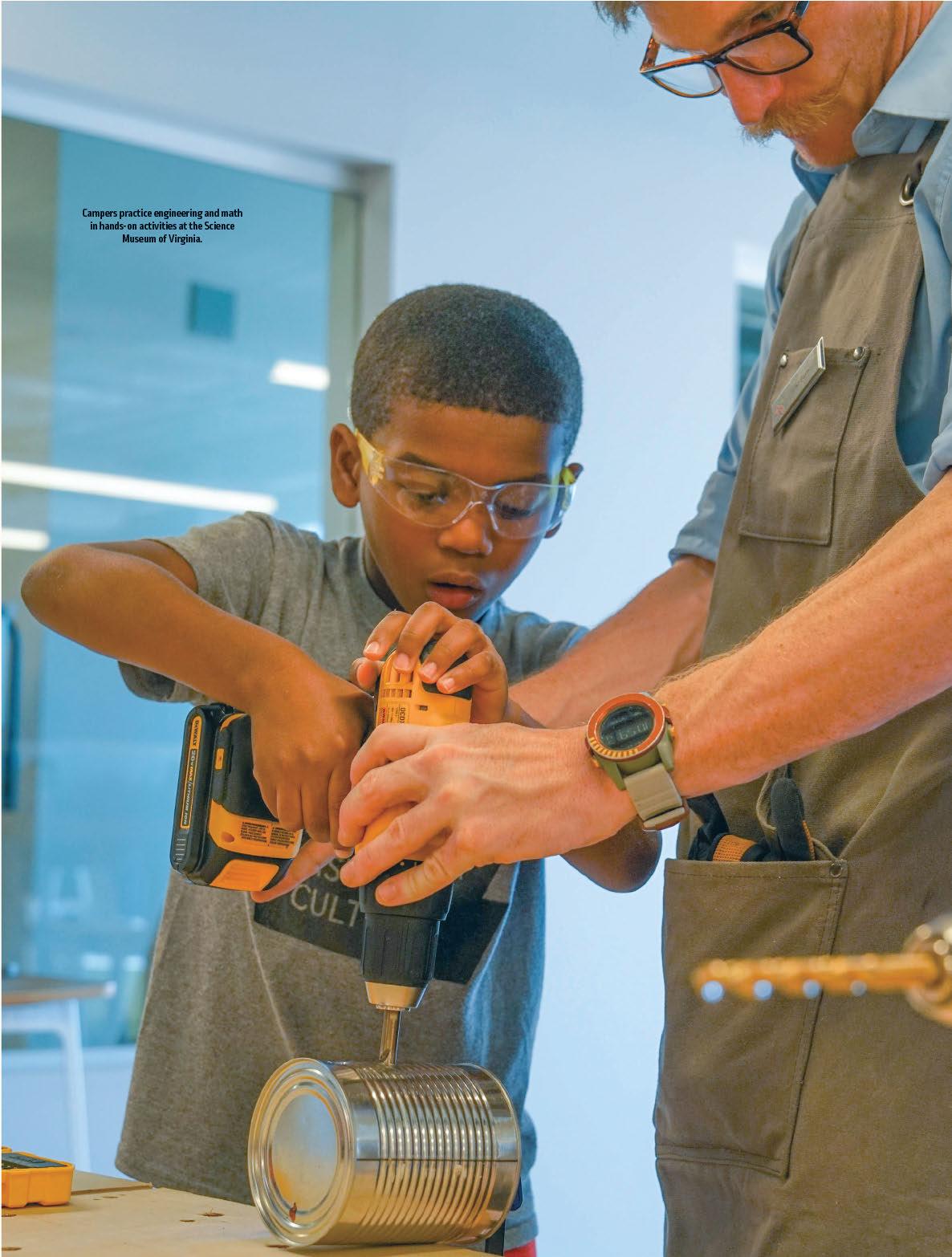
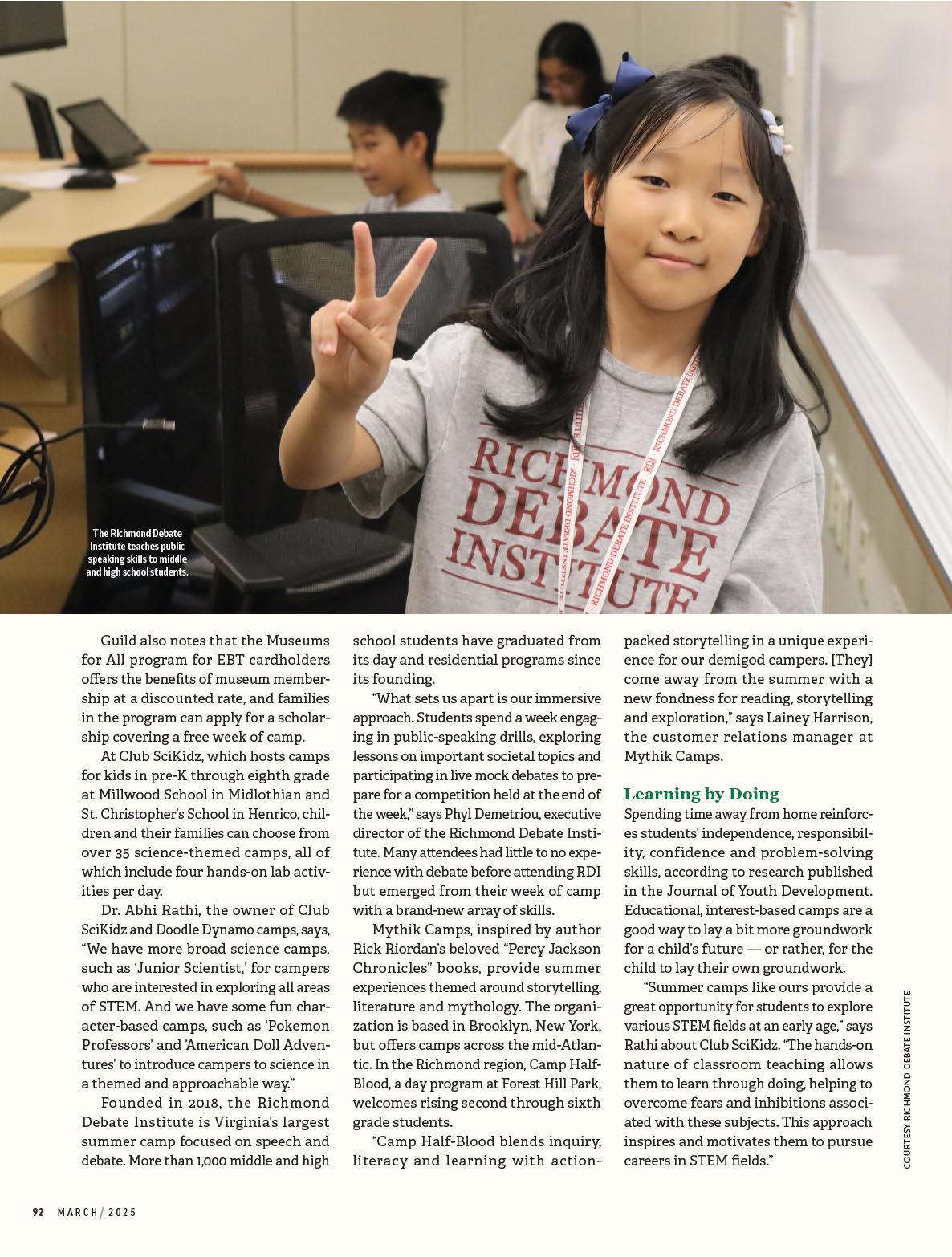

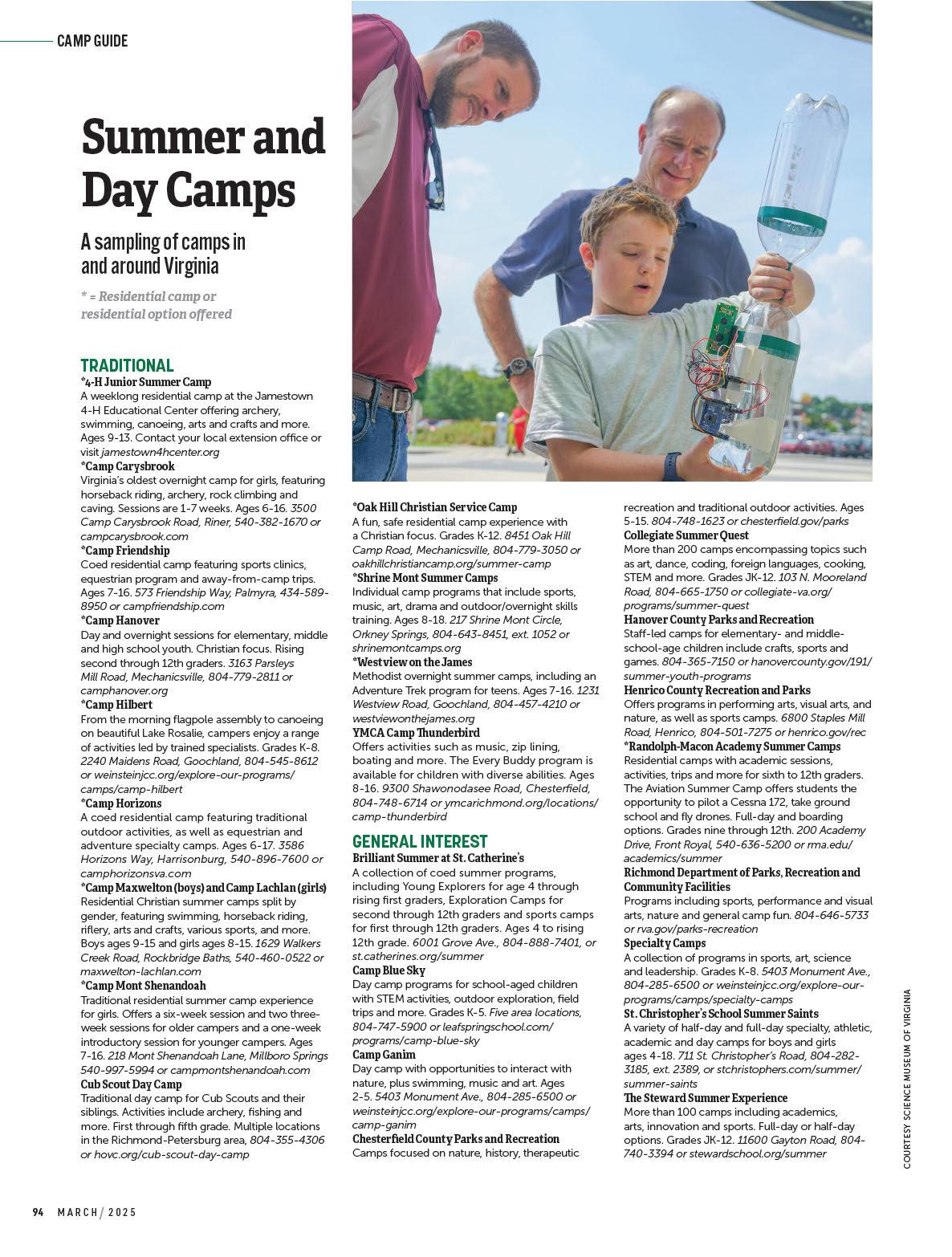
*Summer School at Fork Union Military Academy
A nonmilitary program of leadership and athletic activities for boys, including a father-son weekend. Boarding and day options. Grades 7-12. 4744
James Madison Highway, Fork Union, 434-8424205 or forkunion.com/summer
Summer Spectacular Camps
Programs held at St. Michael’s Episcopal School teach STEAM concepts including coding and engineering as well as sports, baking and outdoor activities. Half-day and full-day options. Ages 4-14. 10510 Hobby Hill Road, 804-272-3514 or stmschool.net/summer-camps
Trinity Summer Discovery Program
Weekly day camps in sports, music, art and academic enrichment. First through 12th graders. 3850 Pittaway Drive, 804-272-5864 or trinityes. org/summer/summer-discovery-program
YMCA of Greater Richmond
Various branch locations o er full-day camps, as well as specialty and sports camps. Ages 2-13. 804-649-9622 or ymcarichmond.org/camp
Benedictine College Preparatory Summer Athletic Camps
Programs in basketball, wrestling, football and soccer for boys. Rising fifth through ninth graders. 12829 River Road, 804-708-9610 or benedictinecollegeprep.org
Golf Camp at Magnolia Green Golf Club
Full- and half-day camps with coach Leighann Albaugh; spring break camp and several oneweek summer camp sessions o ered. Ages 4-15. 7001 Awesome Drive, Moseley, 804-639-5701 or magnoliagreengolfclub.com
Level Green Riding School
Spring and weeklong summer day camp riding program open to all skill levels. Ages 7-16. 3350 John Tree Hill Road, Powhatan, 804-794-8463 or levelgreenriding.com
Martial Arts of West End Summer Camp
O ers martial arts lessons from expert instructors with an emphasis on fitness, positive praise and encouragement and leadership skills for all ages. 10454 Ridgefield Parkway, 804-673-5200 or mawestend.com/program/summer-camp
Own Touch Summer Camps
A di erent soccer and futsal camp each week for beginner, intermediate and advanced soccer players. Ages 7-14. 2101 Maywill St., 804-7741390 or owntouchcentral.com
Passages Adventure Camp
Day camps include climbing, kayaking, zip lining, river swims, mountain biking and more. All gear provided. Ages 5-17. Locations in Richmond and Midlothian, 804-897-8283, ext. 310, or passagesrva.com
Richmond Ice Zone
Basic skating skills camp. Ages 5-12. 636 Johnston-Willis Drive, North Chesterfield,804378-7465 or richmondskating.com/riz
Richmond Kickers Youth Club Summer Camps
Day camps for all skill levels teaching soccer skills. Now merged with Richmond Strikers in one club as Richmond United; visit website for full 2025 details. Ages 6-19. 2001 Maywill St., Ste. 203, rkyouth@richmondkickers.com or richmondkickersyouth.com/camp-programs
Richmond Volleyball Club
Volleyball camps for all skill levels. Grades fifth through 12th. 2921 Byrdhill Road, Henrico, and 200 Karl Linn Drive, North Chesterfield, 804-3583000 or rvc.net/camps
Riverside Outfi ers
Day camps focusing on outdoor adventure at various locations. Ages 6-16. 325 S. 14th St., 804560-0068 or riversideoutfitters.net
Robins Junior Golf
Summer golf camp held at Independence Golf Club with full- and half-day options. Ages 5-14. 600 Founders Bridge Blvd., 804-601-8612 or independencegolfclub.com
RVA Paddlesports Pipeline Adventure Camp
Weeklong summer adventure camp on the James River. O erings include kayaking, rafting, rock climbing, stand-up paddleboarding and swimming. Ages 9-14. 1511 Brook Road, 804898-0697 or rvapaddlesports.com/camps
Saint Gertrude High School Summer Athletic Camps
Sports camps in strength and conditioning, volleyball, basketball, field hockey and softball for rising first through ninth grade girls. 12829 River Road, 804-708-9610 or saintgertrude.org
SkateNation Plus
Basic skating lessons, hockey and figure skating. Eight-week sessions. All ages. 4350 Pouncey Tract Road, 804-364-1477 or richmondskating.com/skp
Sports Center of Richmond (SCOR)
Full- and half-day sports and soccer camps for ages 3-13. 1385 Overbrook Road, 804-257-7267 or scor-richmond.com/camps
University of Richmond Spiders Sports Camps
A wide range of sports camps, including baseball, football, basketball and field hockey for ages 5-17. richmondspiderscamps@richmond.edu or richmondspiderscamps.com
VCU Sports Camps
Basketball, soccer, field hockey, baseball and volleyball camps. Ages 8 and up. 1200 W. Broad St., 804-828-4000 or vcuathletics.com
*Virginia Outside
Mountain biking, fishing, fly fishing, water activities and outside adventure for ages 7-14. Multiple locations, 804-272-6362 or virginiaoutside.com
XL Sports World
Multi-sport camp for ages 5-12, featuring day and half-day sessions. 2300 Oak Lake Blvd., Midlothian, 804-744-4600 or xlrichmond.com
ARTS & HUMANITIES
ArtVenture Summer Camp
Classes at the Visual Arts Center of Richmond for ages 5-14. 1812 W. Main St., 804-353-0094 or visarts.org
Bella Ballerina
Storybook and fairytale-themed dance classes for ages 3-8. Locations in Chesterfield and Short Pump, 804-601-6993 or bellaballerinarva.com/ summer-dance-camp.html
Cadence Camps Jammin’ 2025
Weeklong day camps in contemporary theater, o ering mini and full day programs culminating in a musical performance. Ages 6 to rising ninth grade. P.O. Box 7119, 804-233-4894 or cadencetheatre.org/jammin-2025
Camp Half-Blood
Campers explore the myths of di erent cultures around the globe. From the story of Zeus to tales of Eastern deities, children are transported to a world of imagination. Second to eighth graders. Forest Hill Park, 4021 Forest Hill Ave. 929-3979393 or mythikcamps.com/camp-half-blood CharacterWorks
Day camps in musical theater. Programs o er lessons in theater production, performance and more. Ages 6-18. 2216 Perl Road, 833-296-7571
or cworkstheater.org
Camp ComedySportz
Day camps on improvisation and collaboration, basic acting, and sketches for rising second to 12th graders. 8906-H W. Broad St., 804-266-9377 or cszrichmond.com/comedy-camps
e Cultural Arts Center at Glen Allen
O ers camps and programs that allow children to flourish in the performing and visual arts. Summer and private classes are also available. 2880 Mountain Road, 804-261-2787 or artsglenallen.com
Greater Richmond School of Music
Summer music camps for beginner to advanced levels, including Piano Adventure, Guitar Fundamentals, Choral Odyssey, Mini Musical Theater and more. Grades JK-12. Locations at Atlee, West End, Tuckahoe and South Side, 804442-6158 or grsm.net/summer-music-programs
*GreenSpring Summer Music Institutes
Three weeks of programming, including one week of online sessions. Instruction in a variety of instruments at all skill levels. Ages 8-18. 4101 Grove Ave., 804-353-7001 or greenspringmusic. org/summer-1
Latin Ballet of Virginia Arts in Education Summer Day Camp
Full and half-day camps help students connect dance forms to language and culture. Ages 4-13. The Cultural Arts Center at Glen Allen, 2880 Mountain Road, 804-356-3876 or latinballet.com/camp
Marianne Kelley’s School of Dance
Camps with dancing instruction for ages 3 and up. 1807 Huguenot Road, Suite 115, 804-292-5917 or mksdance.com
e Music Tree
Three one-week summer camps include various musical activities and conclude with a performance. Ages 6-13. 3046 Stony Point Road, 804-571-1973 or themusictreeschool.com
Puppets O Broad Street RVA Circus Arts Camp
A four-day camp for teens and tweens teaching puppetry, juggling, aerial silks, masks and more. Ages 9-15. P.O. Box 26366, 804-358-3377 or puppetso broadstreet.org
School of Rock
Jam out on guitar, bass, keys or drums, work on vocal skills, or explore songwriting. Seven unique camps; no experience needed. Ages 5-18. 4300 Pouncey Tract Road, Suite G, Glen Allen, 804-2123900 or schoolofrock.com/music-camps
SPARC (School of the Performing Arts in the Richmond Community) Summer Camps
Performing arts programs for PK, kindergarten, elementary, middle and high school. Various locations and dates. 804-353-3393 or sparcrichmond.org/summer
Summer Strings on the James
Four-day music camp (violin, viola, cello, bass, harp and guitar) featuring introductory, intermediate and advanced classes. Rising fourth through 12th grade. 3700 James River Road, 804-378-2420 or sites.google.com/ccpsnet.net/ summerstringsonthejames/home
Summer eatre Camp
Performance camps and workshop camps held at Swift Creek Mill Theatre for grades K-12. 17401 U.S. Route 1, South Chesterfield, 804-748-5203 or swiftcreekmill.com/summer-camp
VCU Creative Arts Day Camp
Arts-focused classes in digital media, painting, fibers, and more, taught by VCUarts graduate and undergraduate students at Virginia Commonwealth University. Rising kindergartners


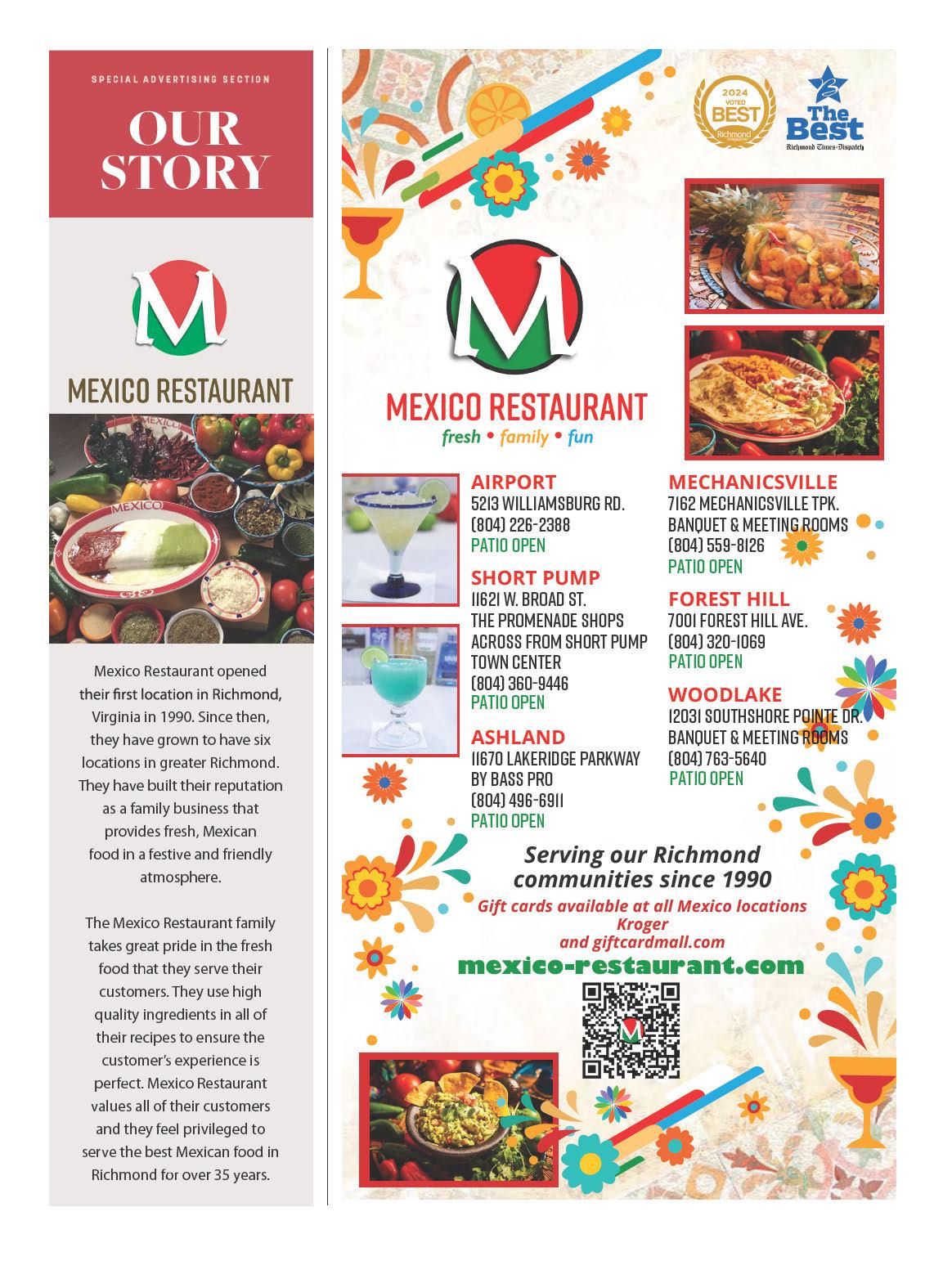

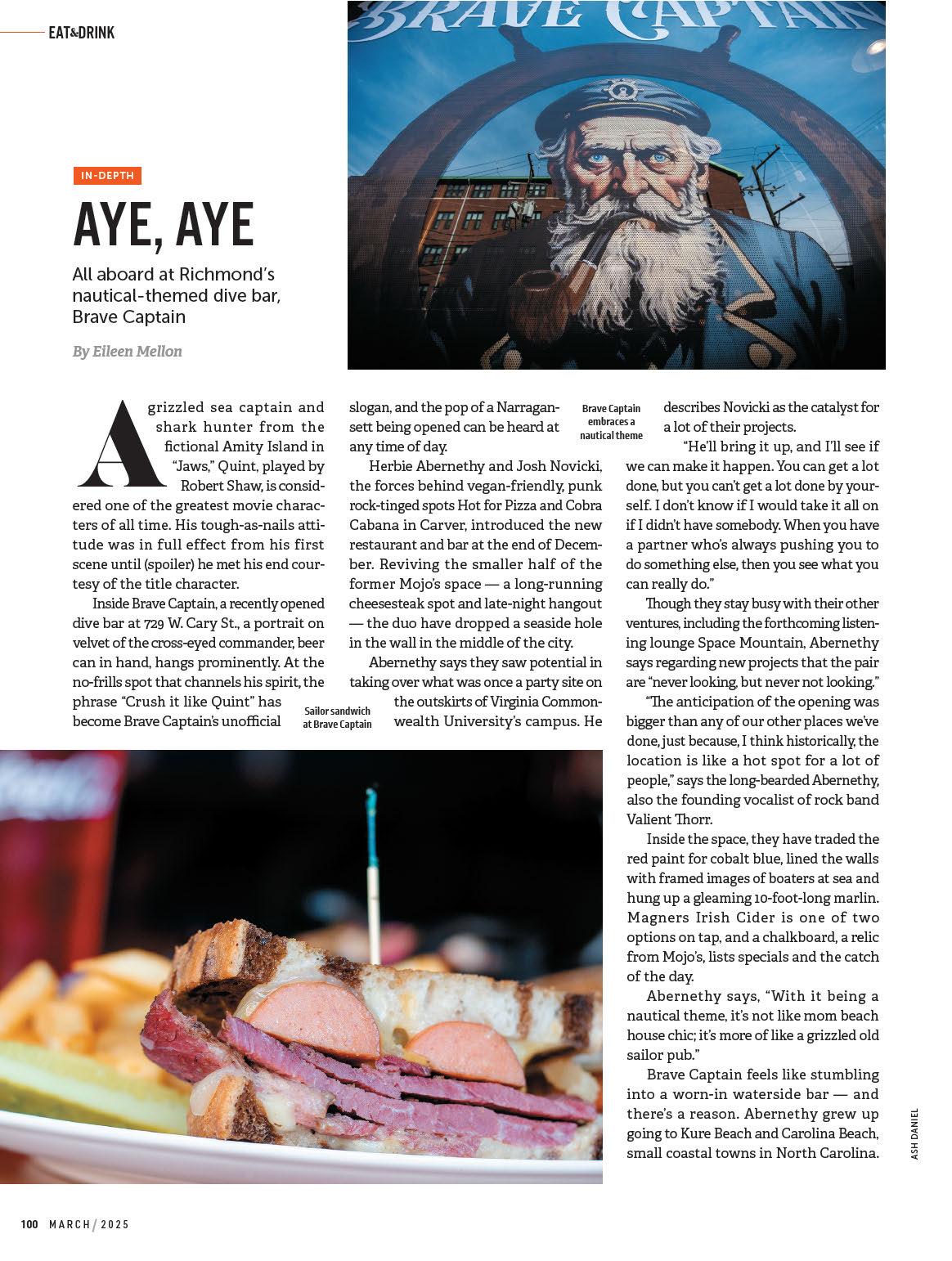

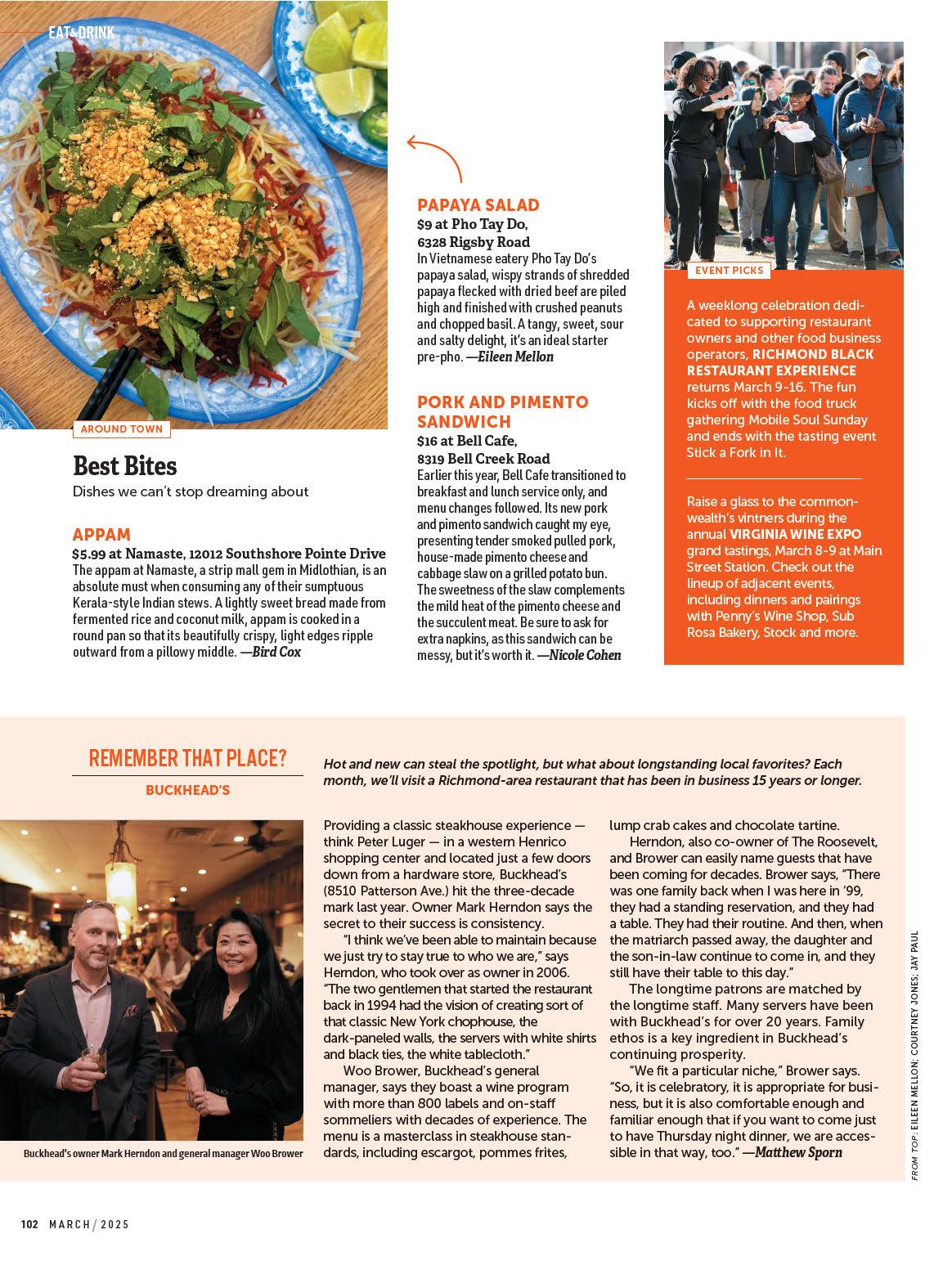


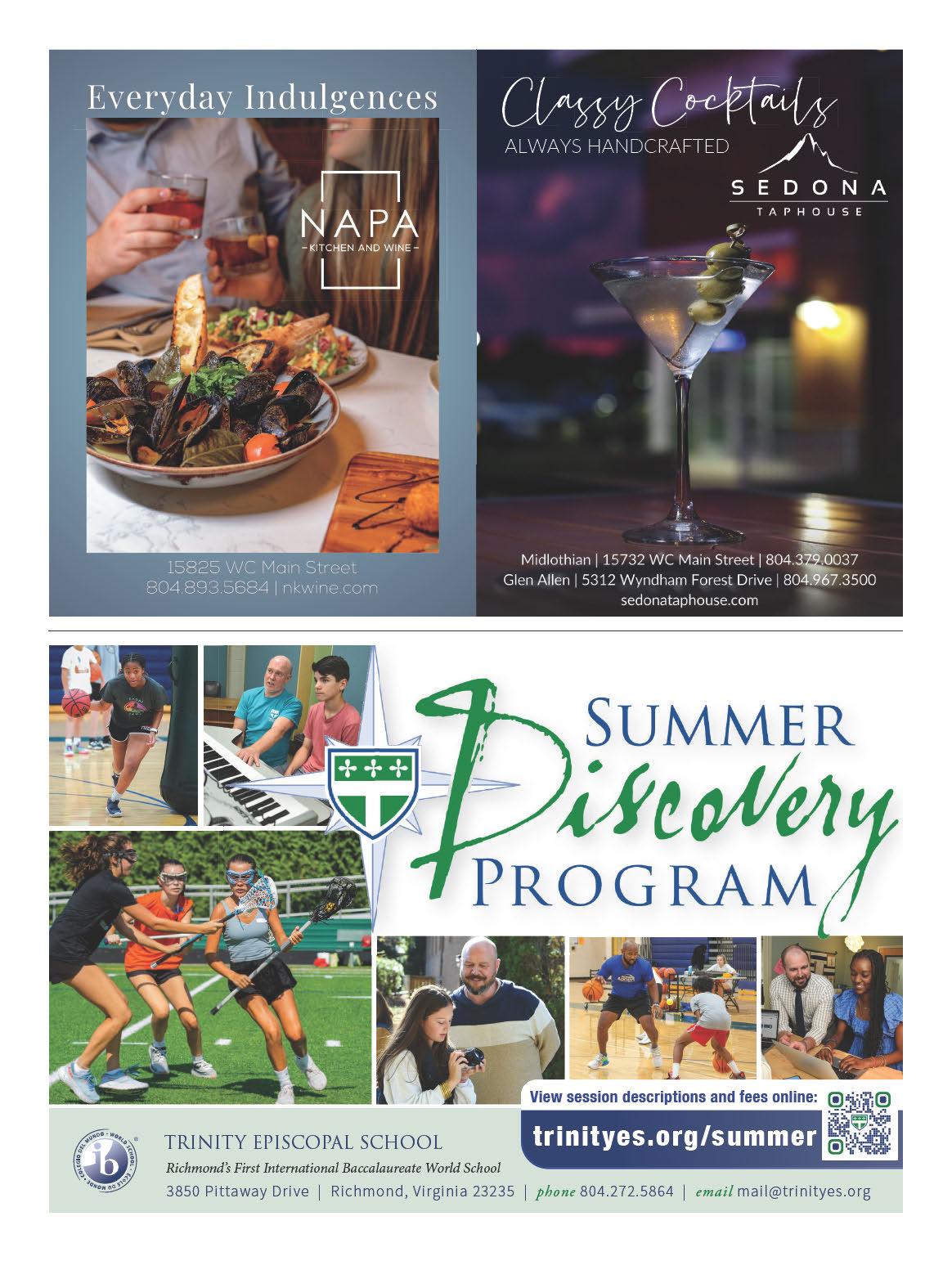

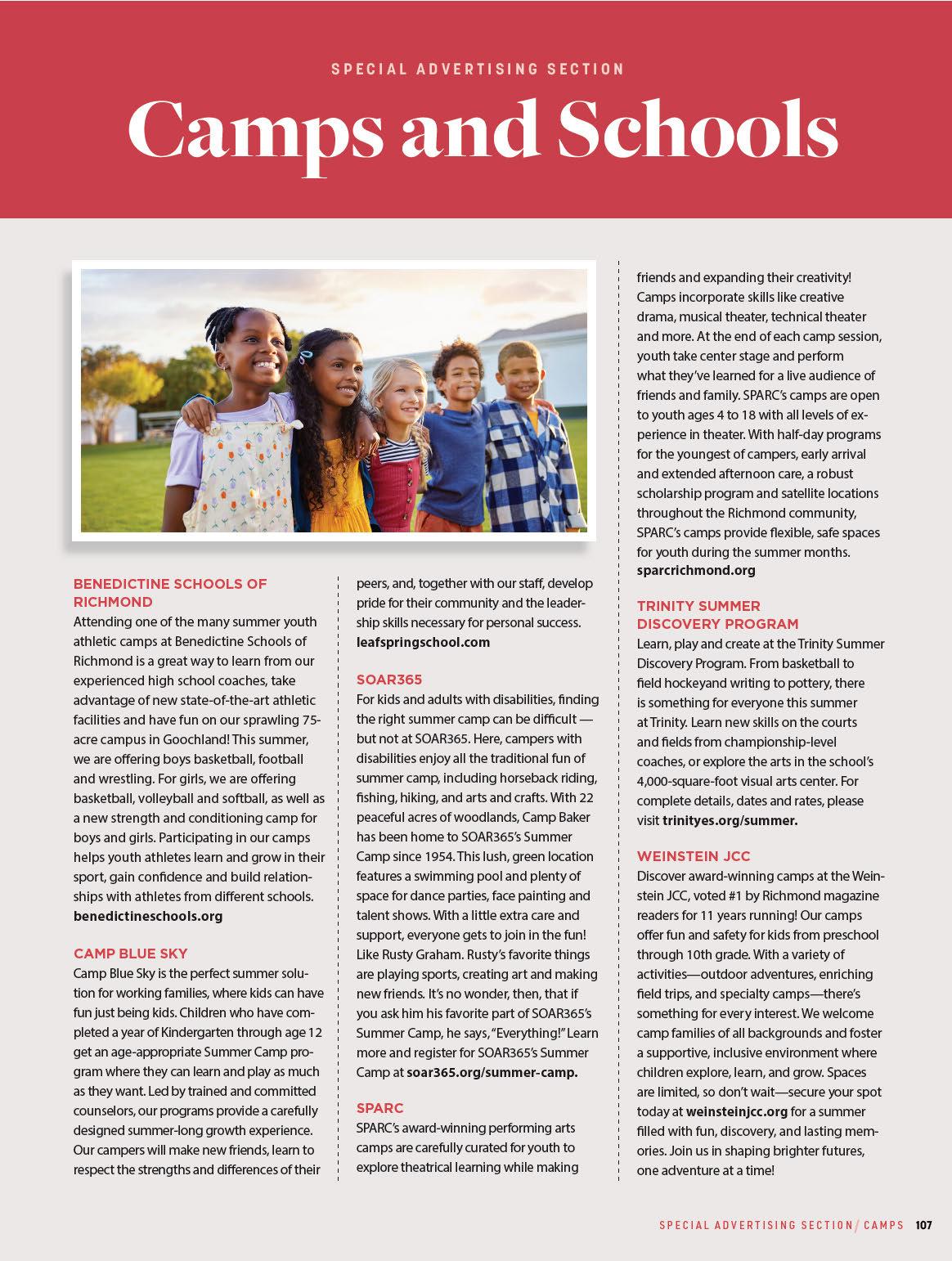




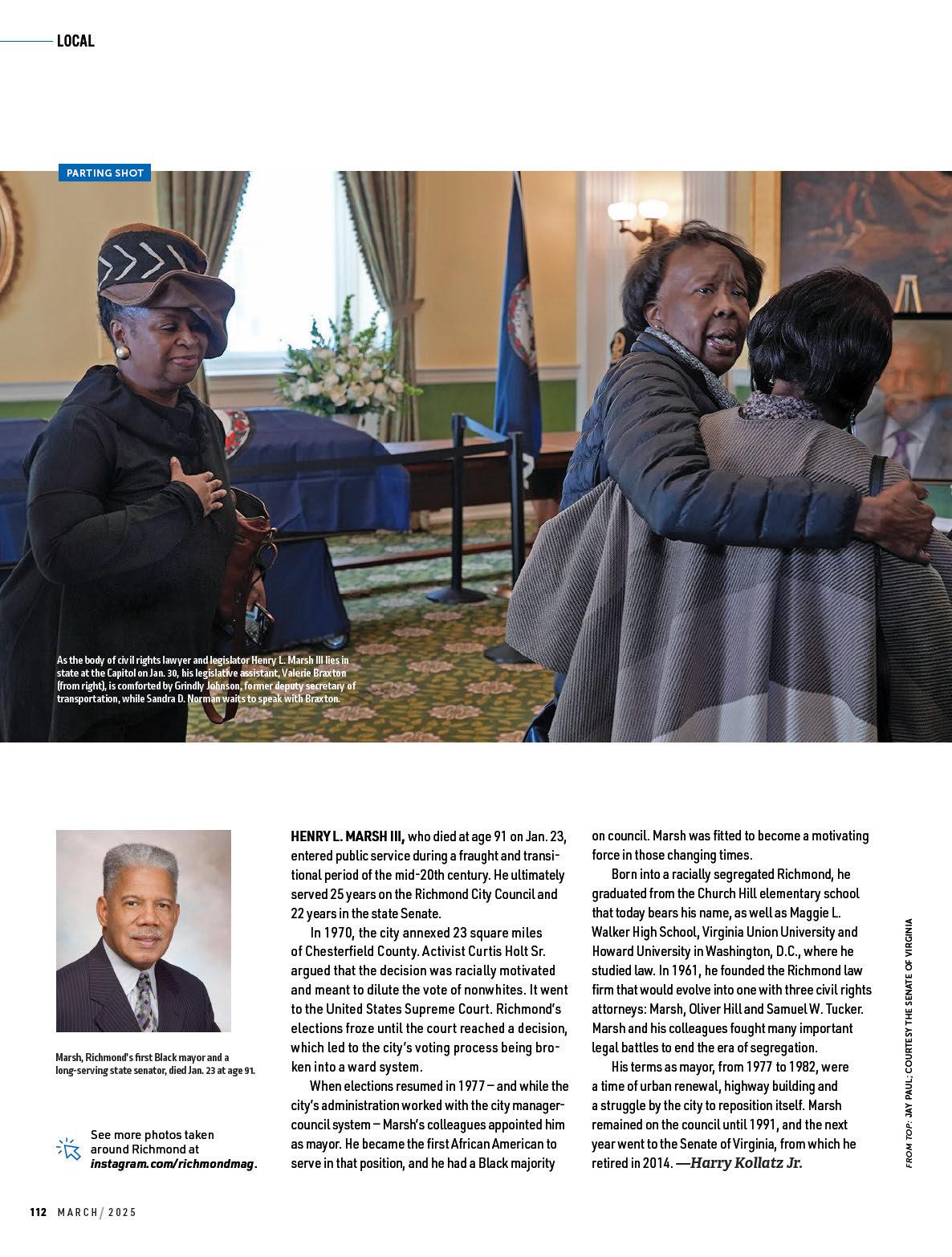





Meet Leslie & Lyndsay of HGTV’s “Unsellable Houses.” They will be presenting on the Fresh Ideas Stage Friday, Feb. 28, at 5 p.m. and Saturday, March 1, at 1 p.m.
Stroll through the feature garden presented by Schultz Landscapes
While you’re in the area, check out the Coffee & Music Lounge with live music from local musicians Luke Bobbitt and Kevin Kelley. Plus, enjoy a cup of java from Coalesce Coffee!
Shop The Marketplace for a variety of items, from tasty treats to unique home décor.
Meet hundreds of experts in landscaping, remodeling, kitchen and bath, home décor, flooring, and more.
Find your dream spa and transform your backyard into a personal oasis at the Spa Blowout, featuring 6,000+ square feet of swim spas and hot tubs. Plus, much more!
Visit www.RichmondHomeAndGarden.com







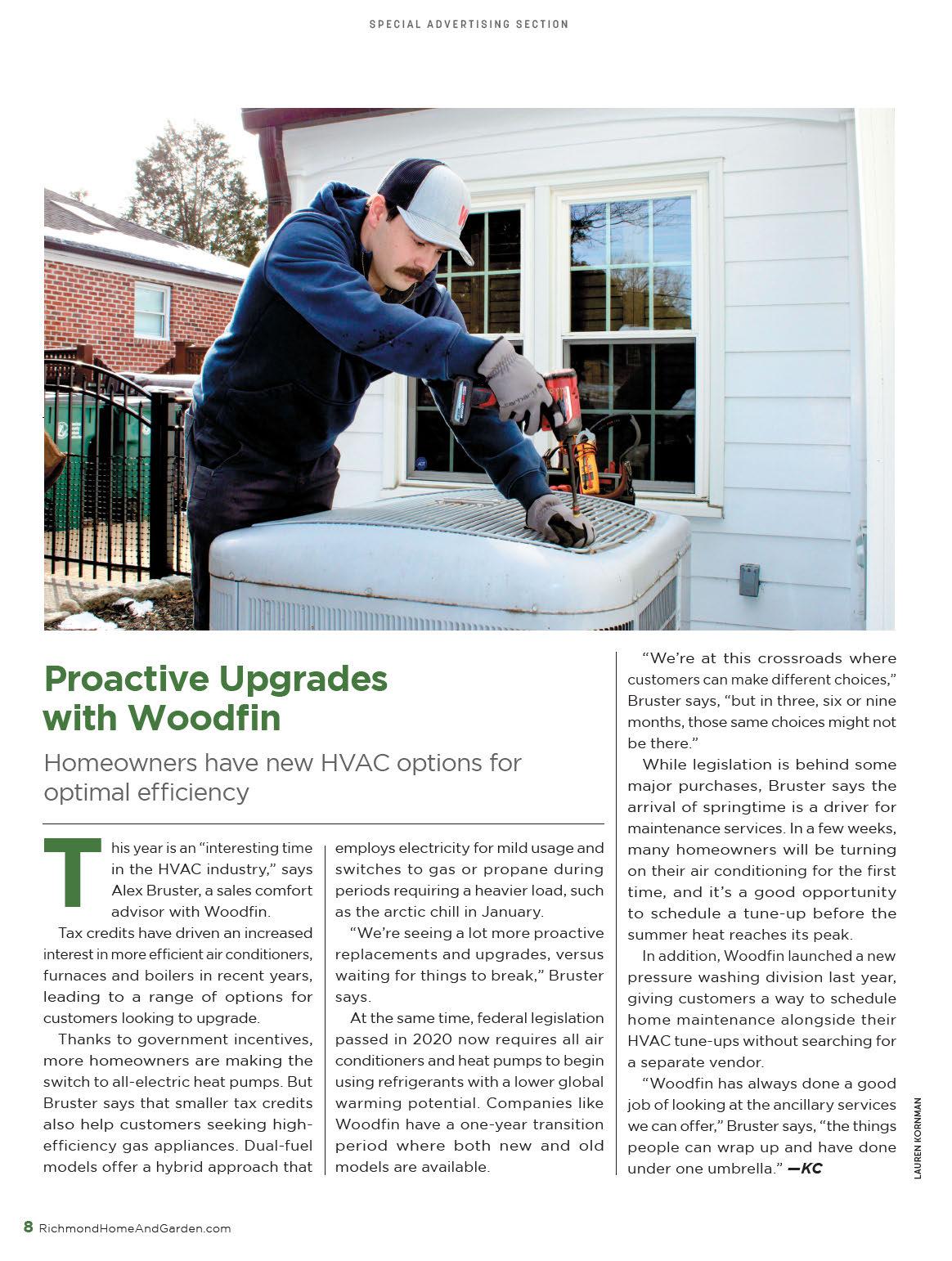

Kaity Bevenour, the owner of Parallel Nursery, says the waning days of winter are the perfect opportunity to walk around your garden and look for
places to add color and depth.
It’s also the time to enjoy spring ephemerals — those plants that bloom early and quickly disappear from the landscape. At Parallel Nursery, those fleeting plants include Virginia bluebells and mayapples. “Mayapples are an umbrella-shaped plant that grows to about a foot tall,” Bevenour says. “It’s the perfect height for box turtles to walk under. They eat the little apple fruit and spread the plant that way.”
“People sometimes limit pollinators to bees and butterflies and birds, but turtles and ants can also be pollinators,” she adds. “That’s one of the reasons we don’t use pesticides. We can’t be sure we’re not harming some other part of the ecosystem.”
Located in eastern Henrico, Parallel
Nursery specializes in native plants and sells about 100 different species through direct email, pop-up markets like Maymont’s Herbs Galore and plant sales at Lewis Ginter Botanical Garden.
For those looking to swap invasive non-native flora for plants that grow naturally in Virginia, Bevenour says there are plenty of wildflowers to choose from. “I encourage people who like to have a lot of summer color to look at the blazing star, or liatris, family,” she says. “Or, if you’re interested in sunflowers and don’t like that they’re annual and you just get one big flower, we have a lot of native sunflowers. That’s a great way to swap native plants into a more traditional garden setting.” —KC
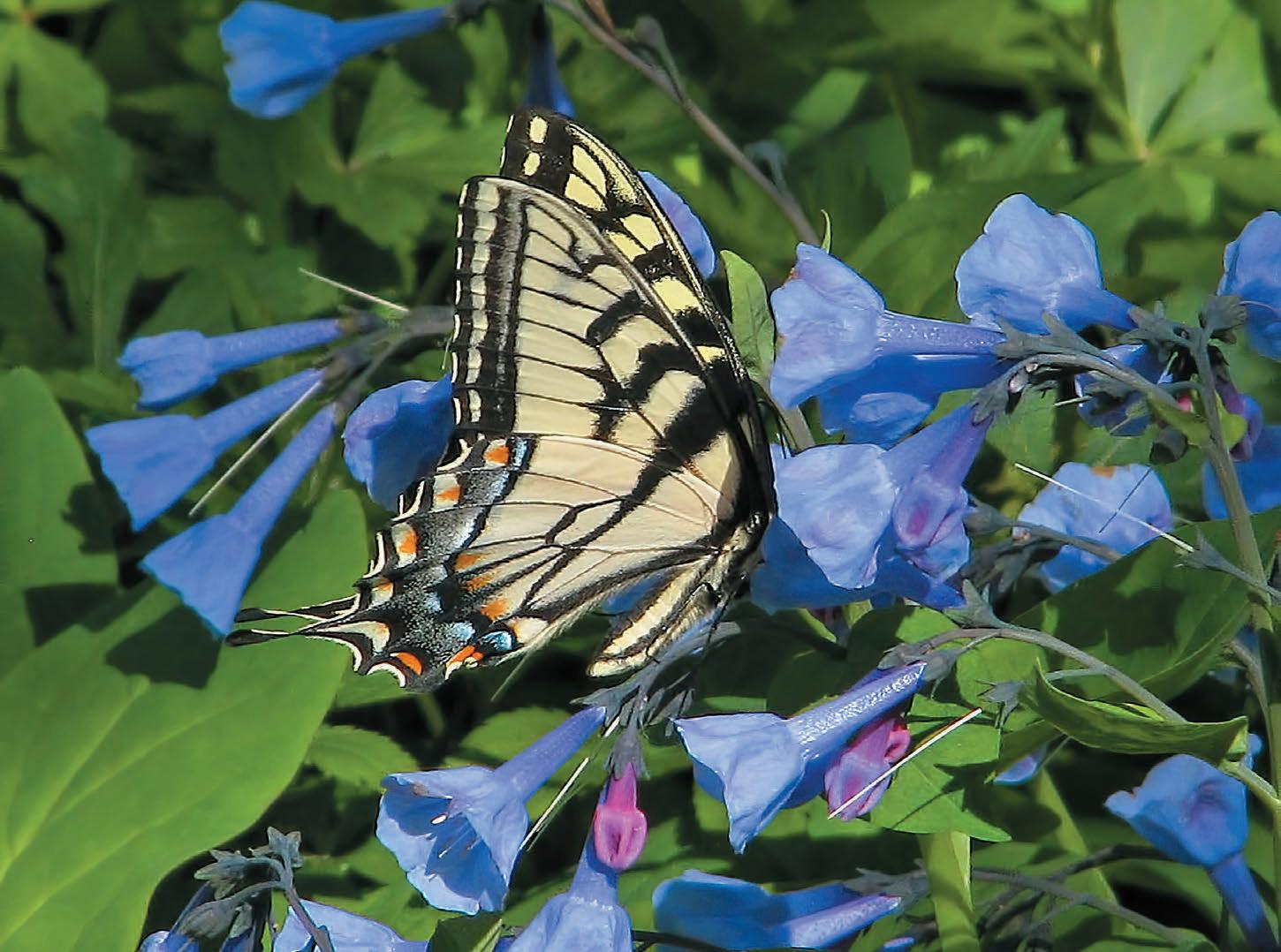

Supporting members during a complex process
With housing shortages, rising prices and changing interest rates, it can seem more challenging than ever to decide when — and whether — to buy a home.
Kerri Fortner, director of real estate lending at Call Federal Credit Union, says their team can help members navigate the process, from understanding financing options to making the most of the equity they have. “Our loan officers are looking at this every day,” she says, “whereas a lot of our members are only doing this once, twice, maybe three times in their lifetime.”
Here, Fortner explains how to approach mortgage financing in a time of uncertainty.
How should prospective buyers think about changing interest rates?
You can watch the trends, but nobody knows for sure what rates are going to do. My biggest advice is to partner with a loan officer who can walk you through that uncertainty.

They can help you focus on finding a comfortable monthly payment instead, because purchase decisions ultimately come down to affordability.
How can Call Federal help prospective buyers find more affordable options?
With our partners, we can provide first-time homebuyers with grants that help with their down payment. We offer rate buy-down options where members can pay a little more up front to get a lower rate long-term. And we offer buyers a guaranteed pre-approval, so that when they do find a house in their price range, they can confidently move forward with a purchase offer.
What if a member decides to stay in their home? Can they invest the equity to make improvements?
We’re definitely seeing more members wanting to turn their current home into their dream home, whether it’s because of a lack of [homes to buy] or high interest rates. At the same time, they’re seeing the value of their home increase and wondering if that gives them an opportunity to use that equity in a smart way. Maybe they want to add an office, add a bedroom, make some upgrades. Our staff can unlock the questions members don’t know they have, make sure they understand fixed and variable rate options, and [help them] understand how to maximize their equity. —KC

